Pioneer DVR-LX60D User Manual

DVR-LX60D HDD/DVD RECORDER
®
 ®
®
Discover the benefits of registering your product online at
http://www.pioneer.co.uk (or http://www.pioneer.eu)
Operating Instructions
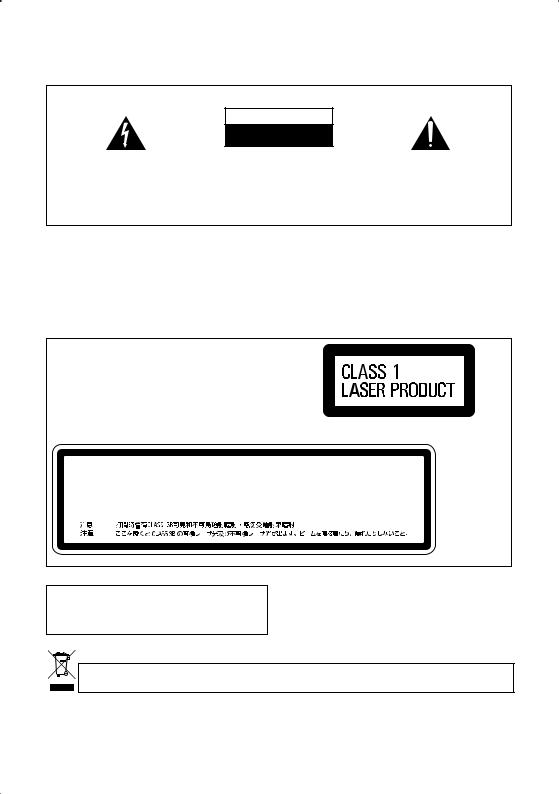
Thank you for buying this Pioneer product.
Please read through these operating instructions so you will know how to operate your model properly. After you have finished reading the instructions, put them away in a safe place for future reference.
IMPORTANT
CAUTION
RISK OF ELECTRIC SHOCK
DO NOT OPEN
The lightning flash with arrowhead symbol, within an equilateral triangle, is intended to alert the user to the presence of uninsulated "dangerous voltage" within the product's enclosure that may be of sufficient magnitude to constitute a risk of electric shock to persons.
CAUTION:
TO PREVENT THE RISK OF ELECTRIC SHOCK, DO NOT REMOVE COVER (OR BACK). NO USER-SERVICEABLE PARTS INSIDE. REFER SERVICING TO QUALIFIED SERVICE PERSONNEL.
The exclamation point within an equilateral triangle is intended to alert the user to the presence of important operating and maintenance (servicing) instructions in the literature accompanying the appliance.
D3-4-2-1-1_En-A
WARNING
This equipment is not waterproof. To prevent a fire or shock hazard, do not place any container filed with liquid near this equipment (such as a vase or flower pot) or expose it to dripping, splashing, rain or moisture.
WARNING
Before plugging in for the first time, read the following section carefully.
The voltage of the available power supply differs according to country or region. Be sure that the power supply voltage of the area where this unit will be used meets the required voltage (e.g., 230 V or 120 V) written on the rear panel.
CAUTION
This product is a class 1 laser product, but this product contains a laser diode higher than Class 1.
To ensure continued safety, do not remove any covers or attempt to gain access to the rear of the product.
Refer all servicing to qualified personnel.
The following caution label appears on your unit. Location: inside of the unit
CAUTION |
CLASS 3B VISIBLE AND INVISIBLE LASER RADIATION WHEN OPEN, AVOID EXPOSURE TO THE BEAM. |
VRW2262 - A |
||||||
ATTENTION |
RADIATIONS LASER VISIBLES ET INVISIBLES DE CLASSE 3B QUAND OUVERT. ÉVITEZ TOUT EXPOSITION AU FAISCEAU. |
|
||||||
ADVARSEL |
KLASSE 3B SYNLIG OG USYNLIG LASERSTRÅLING VED ÅBNING. UNDGÅ UDSÆTTELSE FOR STRÅLING. |
|
||||||
VARNING |
KLASS 3B SYNLIG OCH OSYNLIG LASERSTRÅLNING NÄR DENNA DEL ÄR ÖPPNAD. UNDVIK ATT UTSÄTTA DIG FÖR STRÅLEN. |
|||||||
VORSICHT |
BEI GEÖFFNETER ABDECKUNG IST SICHTBARE UND UNSICHTBARE LASERSTRAHLUNG DER KLASSE 3B IM GERÄTEINNEREN VORHANDEN. |
|||||||
|
NICHT DEM LASERSTRAHL AUSSETZEN! |
|
||||||
PRECAUCIÓN CUANDO SE ABRE HAY RADIACIÓN LÁSER DE CLASE 3B VISIBLE E INVISIBLE. EVITE LA EXPOSICIÓN A LOS RAYOS LÁSER. |
||||||||
VARO! |
AVATTAESSA OLET ALTTIINA NÄKYVÄLLE JA NÄKYMÄTTÖMÄLLE LUOKAN 3B LASERSÄTEILYLLE. ÄLÄ KATSO SÄTEESEEN. |
|||||||
|
|
|
|
|
|
|
|
|
This product complies with the Low Voltage Directive (73/23/EEC, amended by 93/68/EEC), EMC Directives (89/336/EEC, amended by 92/31/EEC and 93/68/EEC).
WARNING
To prevent a fire hazard, do not place any naked flame sources (such as a lighted candle) on the equipment.
If you want to dispose this product, do not mix it with general household waste. There is a separate collection system for used electronic products in accordance with legislation that requires proper treatment, recovery and recycling.
Private households in the member states of the EU, in Switzerland and Norway may return their used electronic products free of charge to designated collection facilities or to a retailer (if you purchase a similar new one).
For countries not mentioned above, please contact your local authorities for the correct method of disposal.
By doing so you will ensure that your disposed product undergoes the necessary treatment, recovery and recycling and thus prevent potential negative effects on the environment and human health.
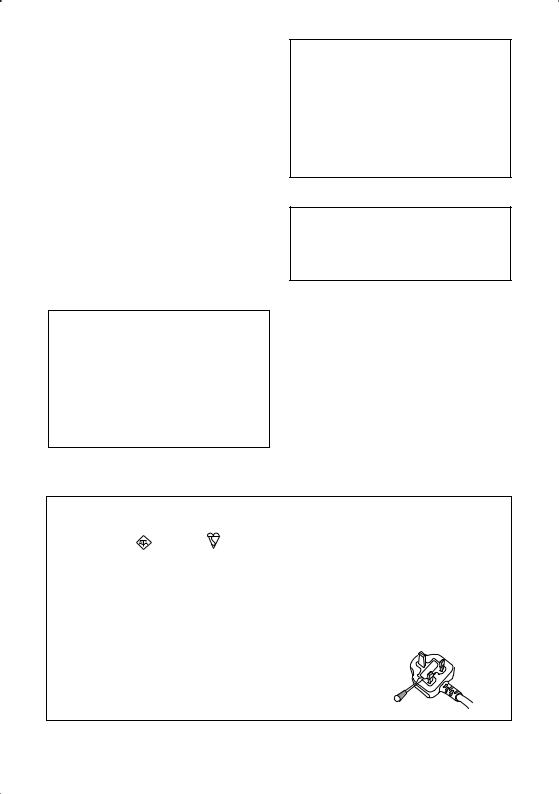
Operating Environment
Operating environment temperature and humidity: +5 ºC to +35 ºC (+41 ºF to +95 ºF); less than 85 %RH (cooling vents not blocked)
Do not install this unit in a poorly ventilated area, or in locations exposed to high humidity or direct sunlight (or strong artificial light)
VENTILATION CAUTION
When installing this unit, make sure to leave space around the unit for ventilation to improve heat radiation (at least 10 cm at top, 10 cm at rear, and 10 cm at each side).
WARNING
Slots and openings in the cabinet are provided for ventilation to ensure reliable operation of the product, and to protect it from overheating. To prevent fire hazard, the openings should never be blocked or covered with items (such as newspapers, table-cloths, curtains) or by operating the equipment on thick carpet or a bed.
CAUTION
The STANDBY/ON switch on this unit will not completely shut off all power from the AC outlet. Since the power cord serves as the main disconnect device for the unit, you will need to unplug it from the AC outlet to shut down all power. Therefore, make sure the unit has been installed so that the power cord can be easily unplugged from the AC outlet in case of an accident. To avoid fire hazard, the power cord should also be unplugged from the AC outlet when left unused for a long period of time (for example, when on vacation).
This product is for general household purposes. Any failure due to use for other than household purposes (such as long-term use for business purposes in a restaurant or use in a car or ship) and which requires repair will be charged for even during the warranty period.
If the AC plug of this unit does not match the AC outlet you want to use, the plug must be removed and appropriate one fitted. Replacement and mounting of an AC plug on the power supply cord of this unit should be performed only by qualified service personnel. If connected to an AC outlet, the cut-off plug can cause severe electrical shock. Make sure it is properly disposed of after removal.
The equipment should be disconnected by removing the mains plug from the wall socket when left unused for a long period of time (for example, when on vacation).
POWER-CORD CAUTION
Handle the power cord by the plug. Do not pull out the plug by tugging the cord and never touch the power cord when your hands are wet as this could cause a short circuit or electric shock. Do not place the unit, a piece of furniture, etc., on the power cord, or pinch the cord. Never make a knot in the cord or tie it with other cords. The power cords should be routed such that they are not likely to be stepped on. A damaged power cord can cause a fire or give you an electrical shock. Check the power cord once in a while. When you find it damaged, ask your nearest PIONEER authorized service center or your dealer for a replacement.
Replacement and mounting of an AC plug on the power supply cord of this unit should be performed only by qualified service personnel.
IMPORTANT: THE MOULDED PLUG
This appliance is supplied with a moulded three pin mains plug for your safety and convenience. A 5 amp fuse is fitted in this plug. Should the fuse need to be replaced, please ensure that the replacement fuse has a rating of 5 amps and that it is approved by ASTA or BSI to BS1362.
Check for the ASTA mark |
or the BSI mark |
on the body of the fuse. |
If the plug contains a removable fuse cover, you must ensure that it is refitted when the fuse is replaced. If you lose the fuse cover the plug must not be used until a replacement cover is obtained. A replacement fuse cover can be obtained from your local dealer.
If the fitted moulded plug is unsuitable for your socket outlet, then the fuse shall be removed and the plug cut off and disposed of safely. There is a danger of severe electrical shock if the cut off plug is inserted into any 13 amp socket.
If a new plug is to be fitted, please observe the wiring code as shown below. If in any doubt, please consult a qualified electrician.
IMPORTANT: The wires in this mains lead are coloured in accordance with the following code: Blue : Neutral Brown : Live
As the colours of the wires in the mains lead of this appliance may not correspond with the coloured markings identifying the terminals in your plug, proceed as follows ;
The wire which is coloured BLUE must be connected to the terminal which is marked with the letter N or coloured BLACK.
The wire which is coloured BROWN must be connected to the terminal which is marked with the letter L or coloured RED.
How to replace the fuse: Open the fuse compartment with a screwdriver and replace the fuse.
D3-4-2-1-2-2_B_En

Contents
01 Before you start
What’s in the box . . . . . . . . . . . . . . . . . . . 6
Putting the batteries in the remote
control. . . . . . . . . . . . . . . . . . . . . . . . . . . . 6
Using the remote control. . . . . . . . . . . . . . 6 Disc/content format playback
compatibility . . . . . . . . . . . . . . . . . . . . . . . 7
About the internal hard disk drive . . . . . . 12 Symbols used in this manual . . . . . . . . . 13
02 Connections
Rear panel connections. . . . . . . . . . . . . . 14 Front panel connections . . . . . . . . . . . . . 15 Connecting a TV antenna . . . . . . . . . . . . 15
Easy connections . . . . . . . . . . . . . . . . . . 16
Using other types of audio/
video output . . . . . . . . . . . . . . . . . . . . . . 16
Connecting to a cable box or satellite receiver . . . . . . . . . . . . . . . . . . . . . . . . . . 17
Connecting an external
decoder box (1) . . . . . . . . . . . . . . . . . . . . 18
Connecting an external
decoder box (2) . . . . . . . . . . . . . . . . . . . . 19
Connecting to an AV amplifier/
receiver . . . . . . . . . . . . . . . . . . . . . . . . . . 20
Connecting using HDMI . . . . . . . . . . . . . 20 Connecting other AV sources . . . . . . . . . 22 Connecting a USB device . . . . . . . . . . . . 22
Plugging in . . . . . . . . . . . . . . . . . . . . . . . 23
03 Controls and displays
Front panel . . . . . . . . . . . . . . . . . . . . . . . 24 Common Interface . . . . . . . . . . . . . . . . . 25 Display . . . . . . . . . . . . . . . . . . . . . . . . . . 26 Remote control . . . . . . . . . . . . . . . . . . . . 27
04 Getting started
Switching on and setting up . . . . . . . . . . 30 For users receiving digital broadcast services . . . . . . . . . . . . . . . . . . . . . . . . . . 33
Setting up the GUIDE Plus+®
system. . . . . . . . . . . . . . . . . . . . . . . . . . . 33
4
05 Using the GUIDE Plus+® electronic programme guide
The GUIDE Plus+® system . . . . . . . . . . 37 Using the GUIDE Plus+® system . . . . . 37
Areas . . . . . . . . . . . . . . . . . . . . . . . . . . . 39
GUIDE Plus+® FAQ and
troubleshooting . . . . . . . . . . . . . . . . . . . 48
06 Using the digital electronic programme guide
The Digital EPG system . . . . . . . . . . . . . 51 Using the Digital EPG . . . . . . . . . . . . . . . 52 Setting timer programmes . . . . . . . . . . . 52 Other useful EPG functions . . . . . . . . . . 57
07 Recording
About DVD recording . . . . . . . . . . . . . . . 59 About HDD recording. . . . . . . . . . . . . . . 60
Recorded audio . . . . . . . . . . . . . . . . . . . 60
Restrictions on video recording . . . . . . . 61 Using the built-in A.TV and
D.TV tuners. . . . . . . . . . . . . . . . . . . . . . . 61
Setting the picture quality/
recording time . . . . . . . . . . . . . . . . . . . . 64
Basic recording from the TV . . . . . . . . . . 64
Pause Live TV . . . . . . . . . . . . . . . . . . . . . 66
About timer recordings . . . . . . . . . . . . . 68 Timer recording FAQ . . . . . . . . . . . . . . . 69 Simultaneous recording and playback (Chase Play) . . . . . . . . . . . . . . . . . . . . . . 70
Recording from an external
component . . . . . . . . . . . . . . . . . . . . . . . 70
Playing your recordings on other DVD players . . . . . . . . . . . . . . . . . . . . . . . . . . 71
Initializing recordable DVD discs . . . . . . 72 DVD-RW Auto Initialize. . . . . . . . . . . . . . 73
08 Playback
Introduction . . . . . . . . . . . . . . . . . . . . . . 74 Basic playback . . . . . . . . . . . . . . . . . . . . 74
Using the Disc Navigator to browse the contents of a disc . . . . . . . . . . . . . . . . . . 78 Scanning discs. . . . . . . . . . . . . . . . . . . . 79
Playing in slow motion . . . . . . . . . . . . . . 79 Frame advance/frame reverse . . . . . . . . 80
The Play Mode menu . . . . . . . . . . . . . . . 80
Displaying and switching subtitles . . . . . 82
En

Switching DVD and DivX
soundtracks . . . . . . . . . . . . . . . . . . . . . . 82
Switching audio channels . . . . . . . . . . . . 83 Switching camera angles . . . . . . . . . . . . 83 Displaying disc information
on-screen . . . . . . . . . . . . . . . . . . . . . . . . 84
14 The Disc Setup menu
Basic settings. . . . . . . . . . . . . . . . . . . . 121 Initialize settings. . . . . . . . . . . . . . . . . . 122 Finalize settings . . . . . . . . . . . . . . . . . . 122 Optimize HDD . . . . . . . . . . . . . . . . . . . 122 Initialize HDD . . . . . . . . . . . . . . . . . . . . 123
09 Playing and recording from a DV camcorder
Playing from a DV camcorder . . . . . . . . . 85 Recording from a DV camcorder . . . . . . . 85
About DV. . . . . . . . . . . . . . . . . . . . . . . . . 87
15 The Video Adjust menu
Setting the picture quality for TV and external inputs . . . . . . . . . . . . . . . . . . . 124
Setting the picture quality for disc
playback . . . . . . . . . . . . . . . . . . . . . . . . 125
10 Editing
Editing options . . . . . . . . . . . . . . . . . . . . 88
The Disc Navigator screen. . . . . . . . . . . . 89
11 Copying and backup
Introduction . . . . . . . . . . . . . . . . . . . . . 100 One Touch Copy . . . . . . . . . . . . . . . . . . 100 Using Copy Lists . . . . . . . . . . . . . . . . . . 102 Using disc backup. . . . . . . . . . . . . . . . . 106
12 Using the Jukebox
Copying music to the HDD . . . . . . . . . . 108 Copying files via USB . . . . . . . . . . . . . . 108 Playing music from the Jukebox . . . . . . 111 Editing Jukebox albums . . . . . . . . . . . . 112
13 The PhotoViewer
Locating JPEG picture files . . . . . . . . . . 113 Changing the display style of the PhotoViewer . . . . . . . . . . . . . . . . . . . . . 114 Playing a slideshow. . . . . . . . . . . . . . . . 114
Reloading files from a disc or
USB device . . . . . . . . . . . . . . . . . . . . . . 115
Importing files to the HDD. . . . . . . . . . . 115 Selecting multiple files or folders . . . . . 116 Copying files to a DVD-R/-RW . . . . . . . . 116 Copying selected files to a
DVD-R/-RW . . . . . . . . . . . . . . . . . . . . . . 117
Editing files on the HDD . . . . . . . . . . . . 118
Printing files . . . . . . . . . . . . . . . . . . . . . 120
16 The Initial Setup menu
Using the Initial Setup menu . . . . . . . . 127 Selecting other languages for
language options . . . . . . . . . . . . . . . . . 142
Using Software Update
(Digital tuner) . . . . . . . . . . . . . . . . . . . . 142
17 Additional information
Setting up the remote to control
your TV . . . . . . . . . . . . . . . . . . . . . . . . . 143
Minimum copying times. . . . . . . . . . . . 144 Manual recording modes . . . . . . . . . . . 145
Troubleshooting . . . . . . . . . . . . . . . . . . 146
If the picture freezes and the front panel and remote control buttons stop
working . . . . . . . . . . . . . . . . . . . . . . . . 150 On-screen displays . . . . . . . . . . . . . . . . 151
Front-panel displays . . . . . . . . . . . . . . . 154
Language code list . . . . . . . . . . . . . . . . 154
Country/Area code list . . . . . . . . . . . . . 155 Screen sizes and disc formats . . . . . . . 155
Handling discs . . . . . . . . . . . . . . . . . . . 156
Cleaning the pickup lens . . . . . . . . . . . 156
Condensation . . . . . . . . . . . . . . . . . . . . 156
Hints on installation . . . . . . . . . . . . . . . 157
Moving the recorder . . . . . . . . . . . . . . . 157
Resetting the recorder . . . . . . . . . . . . . 157
Specifications. . . . . . . . . . . . . . . . . . . . 158
5
En
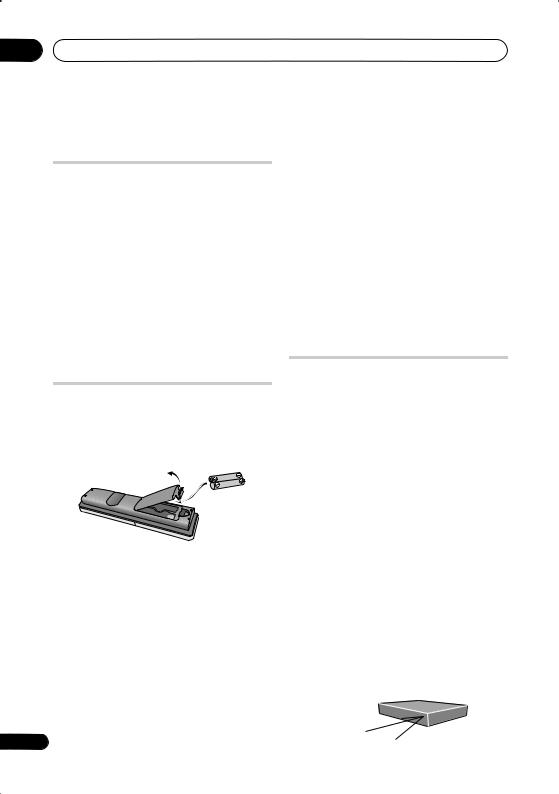
01 Before you start
Chapter 1
Before you start
What’s in the box
Please confirm that the following accessories are in the box when you open it;
•Remote control
•AA/R6P dry cell batteries x 2
•Audio/video cable (red/white/yellow)
•G-LINK™ cable
•RF antenna cable x 2
•Power cable
•These operating instructions
•Warranty card
•Remove batteries from equipment that isn’t going to be used for a month or more.
•When disposing of used batteries, please comply with governmental regulations or environmental public instruction’s rules that apply in your country or area.
WARNING
Do not use or store batteries in direct sunlight or other excessively hot place, such as inside a car or near a heater. This can cause batteries to leak, overheat, explode or catch fire. It can also reduce the life or performance of batteries.
Putting the batteries in the remote control
• Insert two AA/R6P batteries into the battery compartment following the indications ( , ) inside the compartment.
 Important
Important
Incorrect use of batteries can result in hazards such as leakage and bursting. Please observe the following:
•Don’t mix new and old batteries together.
•Don’t use different kinds of batteries together — although they may look similar, different batteries may have different voltages.
•Make sure that the plus and minus ends of each battery match the indications in
6 |
the battery compartment. |
Using the remote control
Please keep in mind the following when using the remote control:
•Make sure that there are no obstacles between the remote and the remote sensor on the unit.
•Remote operation may become unreliable if strong sunlight or fluorescent light is shining on the unit’s remote sensor.
•Remote controllers for different devices can interfere with each other. Avoid using remotes for other equipment located close to this unit.
•Replace the batteries when you notice a fall off in the operating range of the remote.
•When the batteries run down or you change the batteries, the remote control mode is reset to Recorder 1. See Remote Control Mode on page 139.
•Use within the operating range in front of the remote control sensor on the front panel, as shown.

 7 m
7 m
En

Before you start |
01 |
•You can control this recorder using the remote sensor of another Pioneer component via the CONTROL IN jack on the rear panel. See Rear panel connections on page 14 for more information.
Disc/content format playback compatibility
Compatible media
•DVD-RW ver. 1.1 / 1x / 1x to 2x, ver. 1.2 / 2x to 4x / 2x to 6x
•DVD-R ver. 2.0 /1x / 1x to 4x /
1x to 8x / 1x to 16x, ver. 2.1 / 1x to 8x / 1x to 16x
•DVD+RW 1x to 2.4x / 1x to 4x / 3.3x to 8x
•DVD+R 1x to 2.4x / 1x to 4x / 1x to 8x / 1x to 16x
•DVD-RAM ver. 2.0 / 2x, ver. 2.1 / 2x / 2x to 3x / 2x to 5x, ver. 2.2 / 2x / 2x to 3x / 2x to 5x
•DVD-R DL ver. 3.0 / 2x to 4x / 2x to 8x
•DVD+R DL 2.4x / 2.4x to 8x
Note that older models of DVD recorders and DVD writers may reject DVD-RW ver. 1.2 discs and/or corrupt the data on the disc. If you want to share DVD-RW discs between this recorder and an older recorder/writer, we recommend using ver. 1.1 discs.
The following table shows older Pioneer DVD recorders’ limited compatibility with DVDRW ver. 1.2 discs.
Model |
Playable |
Recordable |
DVR-7000 |
Yes*1,2,3 |
No |
DVR-3100/ |
Yes*1 |
No |
DVR-5100H |
|
|
|
|
|
*1 Discs should be finalized in this recorder before playing. Unfinalized VR mode and Video mode discs may not play.
*2 Cannot read the CPRM information will show in the display when you load a disc. However, this will not affect playback.
*3 Copy-once protected disc titles will not play.
Readable file system
This recorder can play DVDs recorded under
the following file systems1: ISO 9660*, UDF 1.02, UDF 1.50, UDF 2.00, UDF 2.01.
* ISO 9660 Level 1 or 2 compliant. Romeo and Joliet file systems are both compatible with this recorder.
 Note
Note
1 • Depending on the recording technique used, even files recorded in compatible file systems may not play correctly.
• MP3/WMA files can be played back when recorded onto a DVD that contains no video files and uses the UDF 7
1.02, UDF 1.50, UDF 2.01 or ISO 9660 file systems.
En
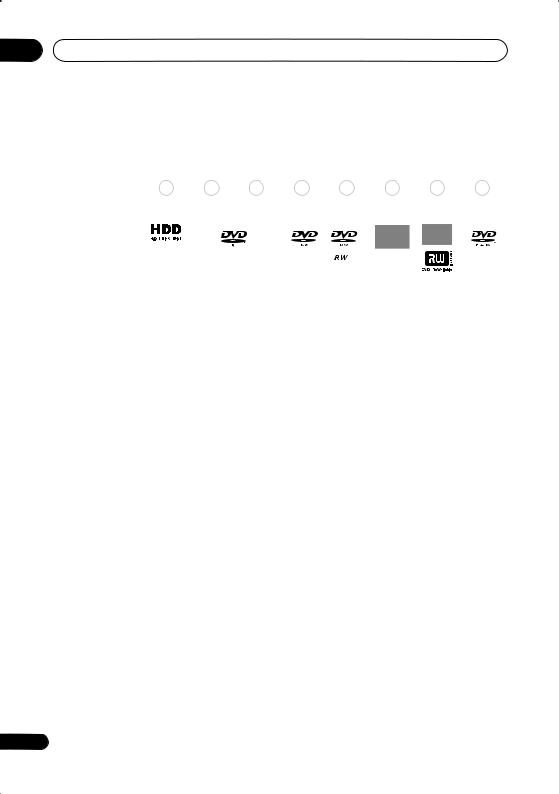
01 Before you start
HDD/DVD Recording and playback compatibility
This recorder can play and record all widely-used DVD disc types, and additionally provides HDD functionality. The table below shows some specific compatibility differences between the different disc types.
|
|
HDD |
|
DVD-R |
DVD-RW |
DVD+R |
|
DVD |
|
DVD- |
|||||||||
|
|
|
|
+RW |
|
RAM |
|||||||||||||
|
|
|
|
|
|
|
|
|
|
|
|
|
|
|
|
||||
|
|
|
|
|
|
|
|
|
|
|
|
|
|
|
|
|
|
|
|
Marks used in this |
|
HDD |
DVD (VR) |
DVD (Video) |
DVD (VR) |
DVD (Video) |
DVD+R |
|
DVD+RW |
|
DVD-RAM |
||||||||
manual |
|
|
|
||||||||||||||||
|
|
|
|
|
|
|
|
|
|
|
|
|
|
|
|
|
|
|
|
|
|
|
*1 |
|
|
*1 |
*2 |
|
|
|
|
|
|
*13, 16 |
|
||||
|
|
|
|
|
|
|
|
|
|
|
|
|
|
|
|
|
|
|
|
Logos |
|
|
|
|
|
|
|
|
|
|
|
|
|
|
|
|
|
|
|
|
|
|
|
|
|
|
|
|
|
|
|
|
|
|
|
|
|
|
|
|
|
|
|
|
|
|
|
|
|
|
|
|
|
|
|
|
|
|
|
|
|
|
|
|
|
|
|
|
|
|
|
|
|
|
|
|
|
|
|
|
|
|
|
|
|
|
|
|
|
|
|
|
|
|
|
|
|
|
|
|
|
|
|
|
|
|
|
|
|
|
|
|
|
|
|
|
|
|
|
|
|
|
|
|
|
|
|
|
|
|
|
|
|
|
|
|
|
|
|
|
|
|
|
|
|
|
|
|
|
|
|
|
|
|
|
|
|
|
|
|
|
|
|
|
|
|
|
|
|
|
|
|
|
|
|
|
|
|
|
Re-recordable/ |
|
|
*3 |
|
*3 |
|
|
|
|
|
|
*3 |
*14 |
|
|
|
|||
Erasable |
|
|
|
|
|
|
|
|
|
|
|
|
|
|
|
|
|
|
|
|
|
|
|
|
|
|
|
|
|
|
|
|
|
|
|
|
|
|
|
Editing of recorded |
|
|
|
|
*4 |
|
*4 |
|
*4 |
*4 |
|
|
|
|
|||||
programmes |
|
|
|
|
|
|
|
|
|
|
|
|
|
|
|
|
|
|
|
|
|
|
|
|
|
|
|
|
|
|
|
|
|
|
|
|
|
|
|
Recording of Copy- |
|
|
*12 |
|
|
*12 |
|
|
|
|
|
|
|
|
|
*12 |
|
||
once protected |
|
|
|
|
|
|
|
|
|
|
|
|
|
|
|
|
|
|
|
material |
|
|
|
|
|
|
|
|
|
|
|
|
|
|
|
|
|
|
|
|
|
|
|
|
|
|
|
|
|
|
|
|
|
|
|
|
|
|
|
Playback in other |
|
n/a |
*5 |
|
*6 |
*7 |
*6 |
|
*6, 15 |
*8 |
|
*9 |
|
||||||
players/recorders |
|
|
|
|
|
|
|
|
|
|
|
|
|
|
|
|
|
|
|
|
|
|
|
|
|
|
|
|
|
|
|
|
|
|
|
|
|
|
|
Chase play |
|
|
|
|
|
|
|
|
|
|
|
|
|
|
|
|
|
|
|
|
|
|
|
|
|
|
|
|
|
|
|
|
|
|
|
|
|
|
|
16:9 and 4:3 |
|
|
|
|
|
|
|
|
|
|
|
|
|
|
|
|
|
|
|
programme |
|
|
|
|
|
|
|
|
|
|
|
|
|
|
|
|
|
|
|
recording |
|
|
|
|
|
|
|
|
|
|
|
|
|
|
|
|
|
|
|
|
|
|
|
|
|
|
|
|
|
|
|
|
|
|
|
|
|
|
|
Bilingual broadcast |
*10, 11 |
*11 |
|
|
*11 |
|
|
|
|
|
|
|
|
|
*11 |
|
|||
recording of both |
|
|
|
|
|
|
|
|
|
|
|
|
|
|
|
|
|
||
audio channels |
|
|
|
|
|
|
|
|
|
|
|
|
|
|
|
|
|
|
|
|
|
|
|
|
|
|
|
|
|
|
|
|
|
|
|
|
|
|
|
Notes to table
*1 Must be initialized for VR mode recording (page 122). *2 Must be initialized for Video mode recording
(page 122).
*3 Erasable, but free space does not increase.
*4 Cannot erase sections, edit chapters or use playlist editing.
*5 Must be compatible with DVD-R(VR) playback.
*6 Finalize using this recorder (may not playback in some units) (page 71).
*7 Must be compatible with DVD-RW(VR) playback.
*8 Must be compatible with DVD+RW playback.
*9 Must be compatible with DVD-RAM playback.
*10 Only when HDD Recording Format is set to Video Mode Off (page 136).
*11 Only when the recording mode is not set to LPCM. 8 *12 CPRM-compatible discs only.
En
*13 Take the disc out of the cartridge before use. Only Panasonic and Maxell discs have been tested to work reliably with this recorder. Discs from other makers may become unusable when recorded or edited.
*14 Erasing a title does not increase the available recording time, nor increase the number of recordable titles left.
*15 Must be compatible with DVD+R playback.
*16 Depending on the disc, it may have to be initialized before it can be recorded (page 122). In this case, initialization will take about an hour.
 is a trademark of DVD Format/Logo Licensing Corporation.
is a trademark of DVD Format/Logo Licensing Corporation.

Before you start |
01 |
Using DVD-R DL/DVD+R DL discs
DVD-R DL (Dual-Layer) and DVD+R DL (Double-Layer) discs contain two recordable layers on a single side, giving about 1.8 times the recording capacity of a conventional single-layer disc. This unit can record to both DVD-R DL and DVD+R DL discs.
•If you intend to play DVD-R DL (Video mode) or DVD+R DL discs recorded on this unit on other DVD recorders/players, you must finalize them. (Note that some DVD recorders/players may not play even finalized DL discs.)
•This logo indicates that the disc is a DVD-R DL or DVD+R DL disc:
Correct operation has been confirmed for DL discs:
•DVD-R DL ver. 3.0/2x to 4x Mitsubishi Kagaku Media (Verbatim)
•DVD-R DL ver. 3.0/2x to 8x Mitsubishi Kagaku Media (Verbatim) That’s
JVC
•DVD+R DL 2.4x
Mitsubishi Kagaku Media (Verbatim) RICOH
•DVD+R DL 2.4x to 8x
Mitsubishi Kagaku Media (Verbatim) RICOH
About DualDisc playback
A DualDisc is a new two -sided disc, one side of which contains DVD content –video, audio, etc. –while the other side contains non-DVD content such as digital audio material.
The non-DVD, audio side of the disc is not compliant with the CD Audio specification and therefore may not play.
It is possible that when loading or ejecting a DualDisc, the opposite side to that being played will be scratched. Scratched discs may not be playable.
The DVD side of a DualDisc plays in this product. DVD-Audio content will not play.
For more detailed information on the DualDisc specification, please refer to the disc manufacturer or disc retailer.
Other disc compatibility
In addition to DVD, this recorder is compatible with a wide range of disc types (media) and formats. Playable discs will generally feature one of the logos on the disc and/or disc packaging shown below. Note however that some disc types, such as recordable CD (and DVD), may be in an unplayable format — see below for further compatibility information.
Audio CD |
CD-R |
CD-RW |
Video CD |
Super Video CD (Super VCD) |
|
CD-R/-RW compatibility
This recorder cannot record CD-R or CD-RW discs.
•Readable formats: CD-Audio, Video CD/ Super VCD, ISO 9660 CD-ROM* containing MP3, WMA, JPEG or DivX files
*ISO 9660 Level 1 or 2 compliant. CD physical format: Mode1, Mode2 XA Form1. Romeo and Joliet file systems are both compatible with this recorder.
•Multi-session playback: Yes (except CDAudio and Video CD/Super VCD)
•Unfinalized disc playback: CD-Audio only
Compressed audio compatibility
•Compatible media: DVD-ROM, DVD-R/-RW, DVD+R/+RW, DVD-RAM, CD-ROM, CD-R, CD-RW, USB
•Compatible formats: MPEG-1 Audio Layer 3 (MP3), Windows Media Audio (WMA)
9
En

01 Before you start
•Sampling rates: 32 kHz, 44.1 kHz or 48 kHz
•Bit-rates: Any (128 kbps or higher recommended)
•Variable bit-rate (VBR) MP3 playback: Yes
•VBR WMA playback: No
•WMA encoder compatibility: Windows Media Codec 8 (files encoded using Windows Media Codec 9 may be playable but some parts of the specification are not supported; specifically, Pro, Lossless, Voice and VBR)
•DRM (Digital Rights Management)1 file playback: No
•File extensions: .mp3, .wma (these must be used for the recorder to recognize MP3 and WMA files – do not use for other file types)
•File structure: Up to 99 folders/999 files (if these limits are exceeded, only files and folders up to these limits are playable)
WMA (Windows Media™ Audio) compatibility
This recorder can playback Windows Media Audio content.
WMA is an acronym for Windows Media Audio and refers to an audio compression technology developed by Microsoft Corporation. WMA content can be encoded by using Windows Media Player for Windows XP, Windows Media Player 9 or Windows Media Player 10 series.
Windows Media is a trademark of Microsoft Corporation.
This product includes technology owned by Microsoft Corporation and cannot be used or distributed without a license from Microsoft Licensing, Inc.
DivX video compatibility
DivX is a compressed digital video format
created by the DivX® video codec from DivX, Inc. This recorder can play DivX video files burned on CD-R/-RW/-ROM discs. Keeping the same terminology as DVD-Video, individual DivX video files are called “Titles”. When naming files/titles on a CD-R/-RW disc prior to burning, keep in mind that by default they will be played in alphabetical order.
•Official DivX® Certified product.
•Plays all versions of DivX® video (including DivX® 6) with standard playback of DivX® media files.
•File extensions: .avi and .divx (these must be used for the recorder to recognize DivX video files). Note that all files with the .avi extension are recognized as MPEG4, but not all of these are necessarily DivX video files and therefore may not be playable on this recorder.
•File structure: Up to 99 folders or 999 files.
DivX, DivX Certified, and associated logos are trademarks of DivX, Inc. and are used under license.
 Note
Note
1DRM (digital rights management) copy protection is a technology designed to prevent unauthorized copying by restricting playback, etc. of compressed audio files on devices other than the PC (or other recording equipment)
10used to record it. For detailed information, please see the instruction manuals or help files that came with your PC and/or software.
En
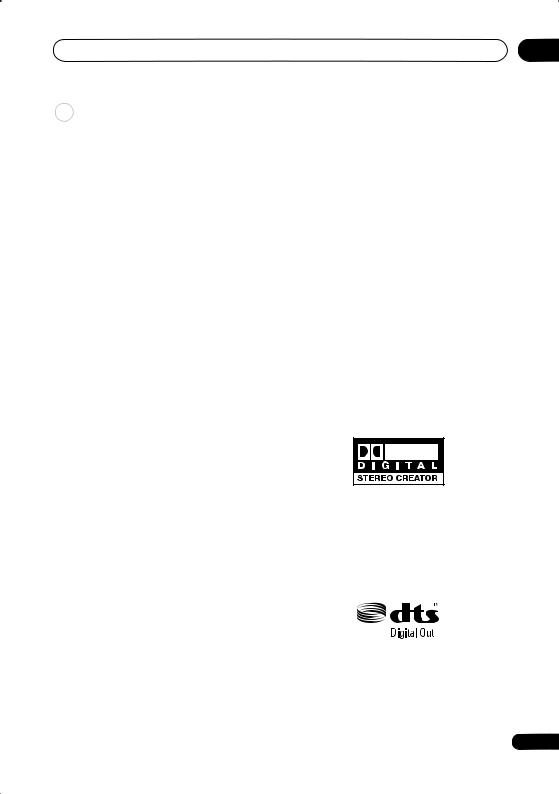
Before you start |
01 |
DivX® VOD content
DivX
In order to play DivX VOD (video on demand) content on this recorder, you first need to register the recorder with your DivX VOD content provider. You do this by generating a DivX VOD registration code, which you submit to your provider.
Some DivX VOD content may only be playable a fixed number of times. When you load a disc containing this type of DivX VOD content, the remaining number of plays is shown on-screen and you then have the option of playing the disc (thereby using up one of the remaining plays), or stopping. If you load a disc that contains expired DivX VOD content (for example, content that has zero remaining plays), the message Rental Expired is displayed.
If your DivX VOD content allows an unlimited number of plays, then you may load the disc into your recorder and play the content as often as you like, and no message will be displayed.
 Important
Important
•DivX VOD content is protected by a DRM system. This restricts playback of content to specific, registered devices.
•If you load a disc that contains DivX VOD content not authorized for this recorder, the message Authorization Error is displayed and the content will not play.
•Resetting the recorder (as described in
Resetting the recorder on page 157) will not cause you to lose your registration code.
•File extensions: .jpg, .jpeg, .jpe, .jif, .jfif (must be used for the recorder to recognize JPEG files – do not use for other file types)
•File structure: The recorder can load up to 99 folders/999 files at one time (if there are more files/folders that this on the disc then more can be reloaded)
PC-created disc compatibility
Discs recorded using a personal computer may not be playable in this unit due to the setting of the application software used to create the disc. In these particular instances, check with the software publisher for more detailed information.
Discs recorded in packet write mode (UDF format) are not compatible with this recorder.
Check the DVD-R/-RW or CD-R/-RW software disc boxes for additional compatibility information.
Dolby Digital
Manufactured under license from Dolby Laboratories. “Dolby” and the double-D symbol are trademarks of Dolby Laboratories.
DTS
JPEG file compatibility
•Compatible formats: Baseline JPEG and EXIF 2.2* still image files
*File format used by digital still cameras
•Sampling ratio: 4:4:4, 4:2:2, 4:2:0
•Horizontal resolution: 160 to 5120 pixels
•Vertical resolution: 120 to 3840 pixels
•Progressive JPEG compatible: No
“DTS” and “DTS Digital Out” are registered trademarks of DTS, Inc.
11
En
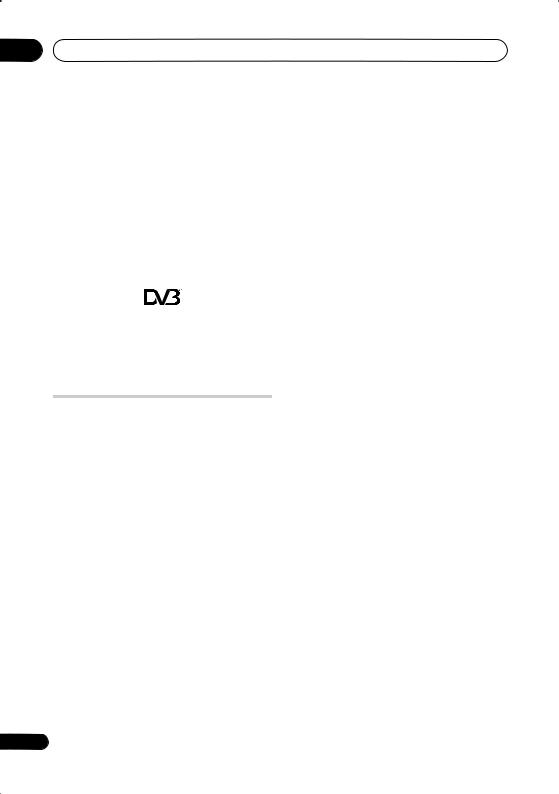
01 Before you start
DVB
The Digital Video Broadcasting Project, or DVB for short, is a set of open standards for digital broadcasting, covering terrestrial, cable and satellite broadcasts.
Based around the MPEG-2 coding system, these open standards ensure that compliant systems are able to work together, independent of manufacturer.
DVB is extremely flexible, being able to deliver virtually any kind of digital content to the home, including High Definition and Standard Definition TV, broadband multimedia content and interactive services.
DVB is a registered trademark of the DVB Project.
About the internal hard disk drive
The internal hard disk drive (HDD) is a fragile piece of equipment. When used without the proper care or in the wrong conditions, it is possible that recorded contents may be damaged or lost entirely, in some cases making even normal playback or recording impossible. Please understand that in the event of repair or replacement of the HDD or related components, all your HDD recordings will be lost.
Please use the recorder following the guidelines below to protect against possible HDD failure.
The HDD should not be regarded as a place to store recordings permanently. We recommend that you back up your important recordings onto DVD discs in order to protect against accidental loss.
Pioneer cannot under any circumstances accept responsibility for any direct or indirect loss arising from any inconvenience or loss of recorded material resulting from HDD failure.
12
•Do not move the recorder while it is on (this includes during EPG download when the display shows EPG).
•Install and use the recorder on a stable, level surface.
•Do not block the rear vent/cooling fan.
•Do not use the recorder in excessively hot or humid places, or in places that may be subject to sudden changes in temperature. Sudden changes in temperature can cause condensation to form inside the recorder. This can be a cause of HDD failure.
•While the recorder is switched on (including during EPG download when the display shows EPG), do not unplug from the wall socket or switch the electricity off from the breaker switch.
•Do not move the recorder immediately after switching it off. If you need to move the recorder, please follow the steps below:
1 After the message POWER OFF is shown on the front panel display, wait at least two minutes.
2 Unplug from the wall socket.
3 Move the recorder.
•If there’s a power failure while the recorder is on there is a chance that some data on the HDD will be lost.
•The HDD is very delicate. If used over time in an improper manner or in an unsuitable environment, it is possible that the HDD will fail. Signs of problems include playback unexpectedly freezing and noticeable block noise (mosaic) in the picture. However, sometimes there will be no warning signs of HDD failure. If the HDD fails, no playback of recorded material will be possible. In this case it will be necessary to replace the HDD unit.
En

Before you start
Optimizing HDD performance
As you record and edit material on the HDD, the data on the disk becomes fragmented, eventually affecting the recorder’s performance. Before this happens, the recorder will warn you that it is time to optimize the HDD (which you can do from the Disc Setup menu; see Optimize HDD on page 122).
01
Symbols used in this manual
The following icons are provided to help you quickly identify which instructions you need for which kind of disc.
HDD |
HDD |
DVD |
Any type of DVD disc |
|
(recordable or playback |
|
only), finalized or not. |
DVD-Video |
Commercially produced |
|
DVD, finalized Video mode |
|
DVD-R/-RW. |
DVD (Video) |
Video mode DVD-R/-RW |
|
(unfinalized) |
DVD (VR) |
VR mode DVD-R/-RW |
DVD+R |
DVD+R |
DVD+RW |
DVD+RW |
DVD-RAM |
DVD-RAM |
CD |
Audio CD |
Video CD |
Video CD |
Super VCD |
Super VCD |
WMA/MP3 |
WMA or MP3 files |
DivX |
DivX files |
A L L |
All of the above |
13
En

02 Connections
Chapter 2
Connections
Rear panel connections
1 |
|
|
2 |
|
|
3 |
|
|
|
|
4 |
5 |
ANTENNA |
R |
AUDIO |
L |
VIDEO |
|
|
|
|
|
|
|
DIGITAL |
|
|
|
|
|
|
|
|
|
||||
|
|
|
|
|
|
|
|
|
|
|
||
IN |
|
|
|
|
|
|
|
|
|
|
|
AUDIO OUT |
|
|
|
S-VIDEO |
|
|
|
|
|
|
|
|
|
|
|
|
|
|
|
|
|
|
|
|
|
|
|
|
|
|
|
INPUT 3 |
AV 2 (INPUT 1/DECODER) |
|
|
|
|
|
AC IN |
|
|
|
|
|
|
|
|
|
|
HDMI OUT |
COAXIAL |
|
|
|
|
|
|
|
|
|
|
ANTENNA(DIGITAL) |
|||
|
|
|
|
|
|
|
G-LINK |
IN |
|
|
||
|
|
|
|
|
|
|
OUT |
IN |
|
|
||
|
|
|
|
|
|
|
|
|
|
|
||
OUT |
|
|
|
|
OUTPUT |
|
|
|
|
|
|
|
|
|
|
|
|
|
|
|
|
|
|
|
|
|
Y |
PB |
|
PR |
|
AV 1 (RGB) – TV |
|
CONTROL |
5 V |
30 mA |
|
|
|
COMPONENT VIDEO OUT |
|
|
|
|
|
|
|
||||
|
|
|
|
|
|
|
|
|
||||
|
|
6 |
|
7 |
|
8 |
9 |
10 |
|
11 |
|
12 |
1 ANTENNA IN (RF IN)/OUT
Connect your TV antenna to the ANTENNA IN (RF IN) jack. The signal is passed through to the ANTENNA OUT jack for connection to your TV.
2 INPUT 3
Stereo analog audio, video and S-video inputs for connection to a VCR or other source component.
3AV2 (INPUT 1/DECODER) AV connector
Audio/video input/output SCART-type AV connector for connecting to a VCR, or other equipment with a SCART connector. The input accepts video, S-video and RGB. See AV2/L1 In on page 132 for how to set this up.
4HDMI OUT
HDMI output for high quality digital audio and video.
5DIGITAL AUDIO OUT (COAXIAL)
Coaxial digital audio jack for connecting to an AV amplifier/receiver, Dolby Digital/DTS/ MPEG decoder or other equipment with a digital input.
6COMPONENT VIDEO OUT
A high-quality video output for connecting to a TV or monitor with a component video input.
7 OUTPUT
Stereo analog audio, video and S-video outputs for connection to a TV or AV
14 amplifier/receiver.
8AV1 (RGB)-TV AV connector
Audio/video output SCART-type AV connector for connecting to a TV or other equipment with a SCART connector. The video output is switchable between video, S-video and RGB. See AV1 Out on page 131 for how to set this up.
9G-LINK™
Use to connect the supplied G-LINK™ cable to enable GUIDE Plus+® to control an external satellite receiver, etc.
10 CONTROL IN
Use to control this recorder from the remote sensor of another Pioneer component with a CONTROL OUT terminal and bearing the Pioneer mark. Connect the CONTROL OUT of the other component to the CONTROL IN of this recorder using a miniplug cord.
11ANTENNA (DIGITAL) IN/OUT
Connect your DTV antenna to the ANTENNA (DIGITAL) IN jack. The signal is passed through to the ANTENNA (DIGITAL) OUT jack for connection to your TV.
12AC IN – Power inlet
En
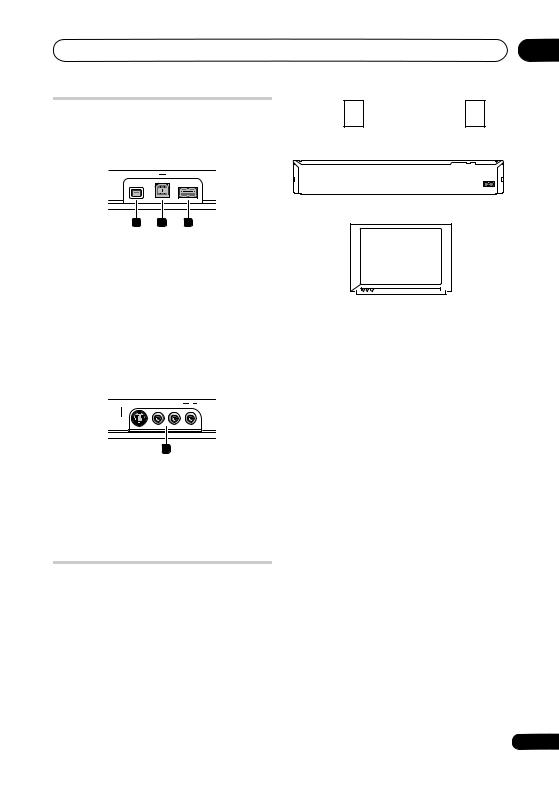
Connections
Front panel connections
On the front panel there is a flip-down cover that hides more connections.
Left side:
DV IN USB 

13 14 15
13 DV IN
A DV input i.LINK connector, suitable for connecting a DV camcorder.
14 USB port (Type B)
USB port for connecting a PictBridgecompatible printer or PC.
15 USB port (Type A)
USB port for connecting a digital camera, keyboard or other USB device.
Right side:
INPUT 2 S-VIDEO VIDEO L(MONO) R AUDIO
16
16 INPUT 2
Audio/video input (stereo analog audio; composite and S-video), especially suitable for camcorders, game consoles, portable audio, etc.
Connecting a TV antenna
This recorder has separate built-in TV tuners for terrestrial digital and terrestrial analog TV broadcasts.
If you are ready to receive digital broadcasts now, use one of the supplied RF antenna cables connect an antenna (either an antenna wall outlet or indoor antenna) to the
ANTENNA (DIGITAL) IN connector. Next, connect the other supplied RF antenna cable to connect an antenna to the ANTENNA IN (RF IN) connector. Lastly, connect the recorder to your TV from the
ANTENNA OUT connector.
02
|
|
|
|
|
|
|
|
|
Antenna wall outlet |
|
|
|
Antenna wall outlet |
|
|
or indoor antenna |
|||
|
ANTENNA |
|
|
|
|
|
ANTENNA |
||
|
IN (RF IN) |
|
|
|
|
|
(DIGITAL) IN |
||
ANTENNA |
R |
AUDIO |
L VIDEO |
|
|
|
|
|
DIGITAL |
IN |
|
|
S-VIDEO |
|
|
|
|
|
AUDIO OUT |
|
|
|
|
|
|
|
|
|
|
|
|
|
|
INPUT 3 |
AV 2 (INPUT 1/DECODER) |
|
|
|
AC IN |
|
|
|
|
|
|
ANTENNA(DIGITAL) |
HDMI OUT COAXIAL |
||
|
|
|
|
|
|
G-LINK IN |
OUT |
IN |
|
OUT |
|
|
|
OUTPUT |
|
|
|
|
|
|
Y |
PB |
PR |
|
AV 1 (RGB) – TV |
CONTROL |
5 V |
30 mA |
|
|
COMPONENT VIDEO OUT |
|
|
|
|
|
|||
ANTENNA
OUT
To antenna input
TV
 Important
Important
•If there is only one antenna outlet on your wall, use a divider.
•Do not connect a component that can receive analog signals to the ANTENNA (DIGITAL) OUT.
If your area is not yet served with terrestrial digital services, connect your antenna’s output to the ANTENNA IN (RF IN) connector using one of the supplied RF antenna cables. Next, connect the recorder to your TV from the ANTENNA OUT connector.
Antenna wall outlet
ANTENNA
IN (RF IN)
ANTENNA |
R |
AUDIO |
L |
VIDEO |
|
|
|
|
|
|
DIGITAL |
IN |
|
|
|
|
S-VIDEO |
|
|
|
|
|
AUDIO OUT |
|
|
|
|
|
|
|
|
|
|
|
|
|
|
|
|
|
INPUT 3 |
AV 2 (INPUT 1/DECODER) |
|
|
|
|
AC IN |
|
|
|
|
|
|
|
ANTENNA(DIGITAL) |
HDMI OUT |
COAXIAL |
||
|
|
|
|
|
|
G-LINK |
IN |
OUT |
IN |
|
|
OUT |
|
|
|
|
OUTPUT |
|
|
|
|
|
|
|
Y |
|
PB |
PR |
|
AV 1 (RGB) – TV |
CONTROL |
5 V |
30 mA |
|
|
|
COMPONENT VIDEO OUT |
|
|
|
|
|
|
||||
ANTENNA
OUT
To antenna input
TV
We strongly recommend using an outdoor antenna for better broadcast picture quality.
If, however, you want to use an indoor antenna, use one with a signal amplifier rated at 5 V, 30 mA and set Aerial Power to On in the Initial Setup menu (see page 129).
15
En

02 Connections
Easy connections
The setup described below is a basic setup that allows you to watch and record TV programmes, and play discs. Other types of connections are explained starting on the following page.
 Important
Important
• These connections use SCART cables (not supplied). If your TV (or VCR) does not have a SCART connection, and you want to use the supplied audio/video cable, see Using the supplied audio/video cable below.
• The AV1 (RGB)-TV AV connector can output ordinary (composite), S-video or RGB video, plus stereo analog audio. The
AV2 (INPUT 1/DECODER) connector accepts ordinary, S-video and RGB video input, as well as stereo analog audio. See AV1 Out on page 131 and AV2/L1 In on page 132 for how to setup these options.
• Before making or changing any rear panel connections, make sure that all components are switched off and unplugged from the wall outlet.
|
|
|
|
|
|
|
1 |
|
|
|
|
To antenna input |
|
Antenna/cable TV |
|
|
|
|
|
|
wall outlet |
||
|
|
|
|
|
|
|
|
From antenna output |
|
|
|
|
|||
|
|
|
|
VCR |
|
|
From SCART AV |
To recorder's |
|
|
|
|
connector |
||
|
|
|
|
|
|||
antenna input |
|
|
|
|
|||
|
|
|
|
|
|
|
3 |
AV2 (INPUT 1/ |
|
|
|
|
|||
DECODER) |
|
|
|
|
|||
ANTENNA R |
AUDIO |
L |
VIDEO |
|
|
|
DIGITAL |
|
|
|
|
|
|||
IN |
|
|
|
|
|
|
AUDIO OUT |
|
|
S-VIDEO |
|
|
|
|
|
|
|
|
INPUT 3 |
AV 2 (INPUT 1/DECODER) |
|
|
AC IN |
|
|
|
|
|
ANTENNA(DIGITAL) HDMI OUT COAXIAL |
||
|
|
|
|
|
G-LINK IN |
||
|
|
|
|
|
OUT |
IN |
|
OUT |
|
|
OUTPUT |
|
|
|
|
|
Y PB |
|
PR |
AV 1 (RGB) – TV |
CONTROL |
5 V |
30 mA |
|
COMPONENT VIDEO OUT |
|
|
|
|||
AV1 (RGB) - TV
|
2 |
|
To SCART AV |
|
connector |
16 |
TV |
1Connect your TV antenna to the recorder and TV.
See Connecting a TV antenna on page 15 for details.
•If you want to incorporate a VCR in your setup, connect it before the recorder (i.e., between the antenna wall outlet and the antenna input on the recorder).
2Use a SCART cable (not supplied) to connect the AV1 (RGB)-TV AV connector on this recorder to the SCART AV connector on your TV.
3Use another SCART cable to connect the AV2 (INPUT 1/DECODER) AV connector to a SCART AV connector on your VCR.
Tip
•This recorder has a ‘through’ function which allows you to record a TV programme from the built-in TV tuner in this recorder while watching a video playing on your VCR (To use this feature when the recorder is in standby, Power Save must be set to Off — see Power Save on page 127).
Using other types of audio/ video output
If you can’t use the SCART AV connector to connect your TV to this recorder, there are standard audio/video output jacks, as well as an S-video and component video output.
Using the supplied audio/video cable
|
To audio input |
|
To video input |
|
TV |
AUDIO |
VIDEO |
OUTPUT |
OUTPUT |
ANTENNA R |
AUDIO |
L |
VIDEO |
1 |
|
|
|
|
|
DIGITAL |
|
2 |
IN |
|
|
|
|
|
|
|
|
AUDIO OUT |
|
|
|
|
|
S-VIDEO |
|
|
|
|
|
|
|
|
|
|
|
|
INPUT 3 |
AV 2 (INPUT 1/DECODER) |
|
|
|
|
AC IN |
|
|
|
|
|
|
|
ANTENNA(DIGITAL) |
HDMI OUT |
COAXIAL |
||
|
|
|
|
|
|
G-LINK |
IN |
OUT |
IN |
|
|
|
OUT |
|
|
|
OUTPUT |
|
|
|
|
|
|
|
Y |
PB |
|
PR |
|
AV 1 (RGB) – TV |
CONTROL |
5 V |
30 mA |
|
|
|
COMPONENT VIDEO OUT |
|
|
|
|
|
|
||||
En
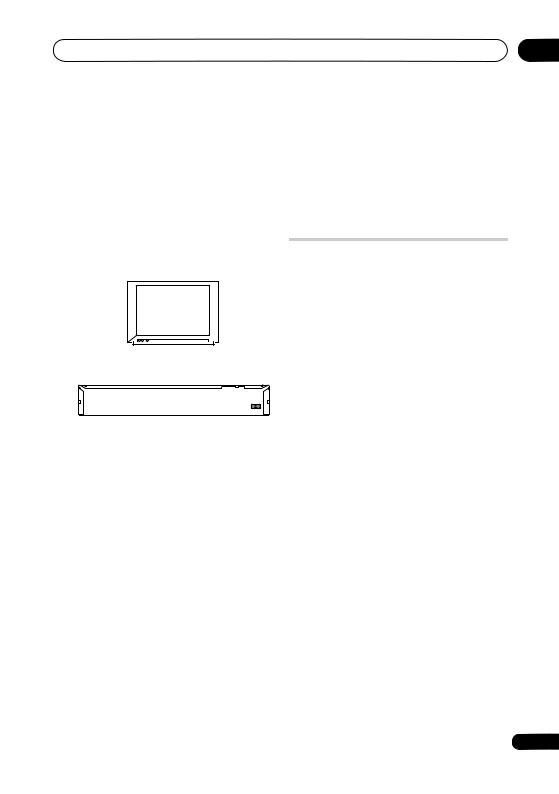
Connections |
02 |
1Connect the VIDEO OUTPUT jack to a video input on your TV.
Use the yellow jack of the supplied audio/ video cable for the video connection.
2Connect the AUDIO OUTPUT jacks to the corresponding audio inputs on your TV.
Use the red and white jacks of the supplied audio/video cable for the audio connection. Make sure you match up the left and right outputs with their corresponding inputs for correct stereo sound.
Using the S-video or component video output
To component video input |
|
|
To video input |
To audio input |
|
2 |
TV |
|
1 |
AUDIO |
S-VIDEO |
OUTPUT |
OUTPUT |
ANTENNA R |
AUDIO |
L |
VIDEO |
|
|
|
|
|
|
DIGITAL |
IN |
|
|
|
|
|
|
|
|
|
AUDIO OUT |
|
|
|
S-VIDEO |
|
|
|
|
|
|
|
|
|
|
|
INPUT 3 |
AV 2 (INPUT 1/DECODER) |
|
|
|
|
AC IN |
|
|
|
|
|
|
ANTENNA(DIGITAL) |
HDMI OUT |
COAXIAL |
||
|
|
|
|
|
G-LINK |
IN |
|
|
||
|
|
|
|
|
OUT |
IN |
|
|
||
OUT |
|
|
|
OUTPUT |
|
|
|
|
|
|
Y |
PB |
|
PR |
|
AV 1 (RGB) – TV |
CONTROL |
5 V |
30 mA |
|
|
COMPONENT VIDEO OUT |
|
|
|
|
|
|
||||
COMPONENT
VIDEO OUT
1 Connect the S-video or component video output to a similar input on your TV.
For an S-video connection, use an S-video cable (not supplied) to connect the S-VIDEO OUTPUT jack to an S-video input on your TV.
For a component video connection, use a component video cable (not supplied) to connect the COMPONENT VIDEO OUT jacks to a component video input on your TV.
See also Component Video Out on page 131 for how to set up the component video output for use with a progressive scancompatible TV.
2 Connect the AUDIO OUTPUT jacks to the corresponding audio inputs on your TV.
You can use the supplied audio/video cable, leaving the yellow video plug disconnected. Make sure you match up the left and right outputs with their corresponding inputs for correct stereo sound.
Connecting to a cable box or satellite receiver
If you have a cable box or satellite receiver with a built-in decoder, connect it to this recorder and your TV as shown on this
page.1 If you are using a separate decoder box for your cable/satellite TV, set up following the instructions on the next page.
Using the setup on this page you can:
•Record any channel by selecting it on the cable box, satellite receiver or digital terrestrial receiver.
•Change channels and set timer recordings on the external receiver using the GUIDE Plus+® system (via the G-LINK™ cable, and after setting up).
 Important
Important
•Do not connect this recorder to your TV ‘through’ your VCR, satellite receiver or other component. Always connect each component directly to your TV or AV amplifier/receiver.
•When using the GUIDE Plus+ system to make a timer recording from an external receiver, make sure that the external receiver is switched on.
 Note
Note
1 The diagram shows SCART video connections, but you can alternatively use any of the other audio/video |
17 |
connections. |
En |
|

02 |
Connections |
|
|
|
|
|||||
|
|
|
|
|
|
|
|
|
|
1 |
|
|
|
|
|
To antenna input |
|
|
|
Satellite dish/ |
|
|
|
|
|
|
|
|
|
antenna/cable TV |
||
|
|
|
|
|
|
|
|
|
|
|
|
From antenna output |
|
|
|
|
|
wall outlet |
|||
|
|
|
|
|
|
|
||||
|
|
|
|
|
Cable/Satellite |
|
|
|
From SCART AV |
|
|
|
|
|
|
receiver |
|
|
|
|
connector |
|
To recorder's |
|
|
|
|
|
3 |
|
|
|
|
antenna input |
|
|
AV2 (INPUT 1/ |
|
|
||||
|
|
|
|
|
|
|
|
|||
|
|
|
|
|
|
DECODER) |
|
4 |
||
|
ANTENNA R |
AUDIO |
L |
VIDEO |
|
|
|
|
|
DIGITAL |
|
IN |
|
|
S-VIDEO |
|
|
|
|
|
AUDIO OUT |
|
|
|
|
|
|
|
|
|
|
|
|
|
|
|
INPUT 3 |
AV 2 (INPUT 1/DECODER) |
|
|
|
|
AC IN |
|
|
|
|
|
|
ANTENNA(DIGITAL) |
HDMI OUT |
COAXIAL |
||
|
|
|
|
|
|
G-LINK IN |
OUT |
IN |
|
|
|
OUT |
|
|
OUTPUT |
|
|
|
|
|
|
|
|
Y PB |
|
PR |
AV 1 (RGB) – TV |
CONTROL |
5 V |
30 mA |
|
|
|
|
COMPONENT VIDEO OUT |
|
|
|
|
|
|||
AV1 (RGB) - TV
2
To SCART AV
connector
TV
1Connect RF antenna cables as shown.
See Connecting a TV antenna on page 15 for more on RF antenna connections, including from this recorder to your TV.
2Use a SCART cable (not supplied) to connect the AV1 (RGB)-TV AV connector to a SCART AV connector on your TV.
This enables you to watch discs.
3Use another SCART cable to connect the AV2 (INPUT 1/DECODER) AV connector to a SCART AV connector on your cable box/satellite receiver.
This enables you to record scrambled TV channels.
4Plug the supplied G-LINK™ cable to the G-LINK™ jack.
This enables you to control the tuner in the external receiver using the GUIDE Plus+® system.
18
Position the IR transmitter end of the G-LINK™ cable so that the IR receiver on your cable/satellite receiver will pick up the control signals (see diagram).
O
S-VIDEO
INPUT 3
AV 2 (INPUT 1/DECODER)
G-LINK IN
OUTPUT
CONTROL
AV 1 (RGB) – TV
G-LINK cable
See the manual that came with your cable/ satellite receiver if you’re not sure where the IR receiver is on the front panel.
Alternatively, experiment with the remote control, operating it from very close range until you find the place where the receiver responds.
 Tip
Tip
•This recorder has a ‘through’ function which allows you to record a TV programme from the built-in TV tuner in this recorder while watching a video playing on your VCR (To use this feature when the recorder is in standby, Power Save must be set to Off — see Power Save on page 127).
Connecting an external decoder box (1)
If you have an external, dedicated decoder box for your satellite or cable TV system, use the setup described on this page. See above for how to connect the G-LINK™ cable.
 Important
Important
•Do not connect your decoder box directly to this recorder.
•Information from the decoder (for example, relating to pay TV services), is only viewable when this recorder is off (in standby).
•For timer recording to work properly on this recorder, the VCR/satellite receiver/ cable box must also be switched on during recording.
En
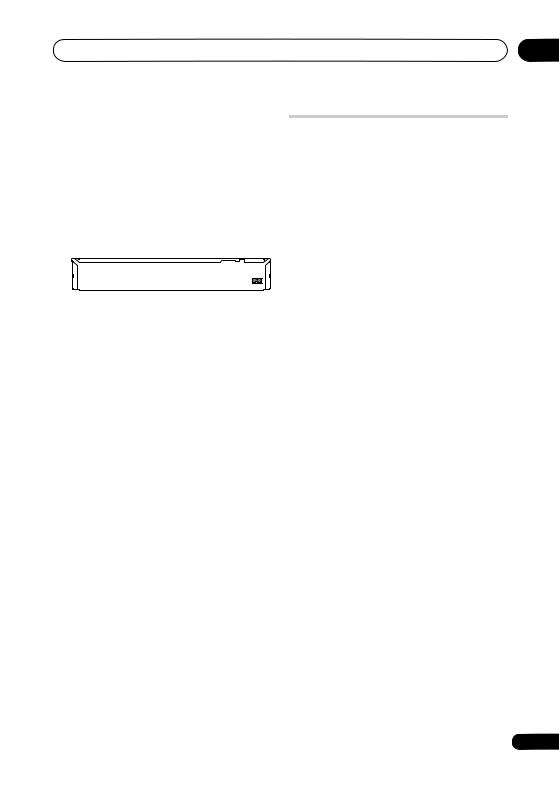
Connections
•It is not possible to watch one TV programme and record another using this setup.
|
|
|
|
|
|
|
|
|
1 |
|
|
|
|
|
|
|
|
|
|
|
|
|
|
|
|
|
|
|
|
|
|
|
|
|
|
|
|
|
|
|
|
|
|
|
|
|
|
|
|
|
|
|
|
Antenna/cable TV |
|
|
|
|
|
|
|
|
|
||||||||
wall outlet |
|
|
|
|
|
|
|
|
|
||||||||
|
|
|
|
|
|
|
|
|
To antenna input |
||||||||
|
|
|
|
|
|
|
|
|
|
|
|
|
|
|
|
|
|
|
|
|
|
|
|
|
|
|
|
|
|
||||||
|
From SCART AV |
VCR/Satellite receiver |
|||||||||||||||
|
connector |
/Cable box |
|||||||||||||||
|
|
|
|
|
|
|
|
|
3 |
|
|
|
|
|
|
|
|
SCART AV connection
2
Decoder
AV2 (INPUT 1/
DECODER)
ANTENNA R |
AUDIO |
L |
VIDEO |
|
|
|
|
|
|
DIGITAL |
|
|
|
|
|
|
|
|
|||
IN |
|
|
|
|
|
|
|
|
|
AUDIO OUT |
|
|
|
S-VIDEO |
|
|
|
|
|
|
|
|
|
|
|
INPUT 3 |
AV 2 (INPUT 1/DECODER) |
|
|
|
|
AC IN |
|
|
|
|
|
|
|
|
HDMI OUT |
COAXIAL |
|
|
|
|
|
|
G-LINK |
IN |
ANTENNA(DIGITAL) |
|||
|
|
|
|
|
OUT |
IN |
|
|
||
OUT |
|
|
|
OUTPUT |
|
|
|
|
|
|
Y |
PB |
|
PR |
|
AV 1 (RGB) – TV |
CONTROL |
5 V |
30 mA |
|
|
COMPONENT VIDEO OUT |
|
|
|
|
|
|
||||
AV1 (RGB) - TV
4
To SCART AV
connector
TV
1Connect the cable from the antenna/ cable TV outlet to the antenna input on your VCR/satellite receiver/cable box.
2Use a SCART cable (not supplied) to connect your decoder to your VCR/ satellite receiver/cable box.
See the manual for your decoder box for more detailed instructions.
3Use a SCART cable to connect your VCR/satellite receiver/cable box to the AV2 (INPUT 1/DECODER) AV connector on this recorder.
02
Connecting an external decoder box (2)
If you only have a decoder, connect it to this recorder and your TV as shown on this
page.1
Using the setup on this page you can:
•Record scrambled channels received using the recorder’s built-in analog TV tuner.
Important
•Do not connect this recorder ‘through’ your VCR, satellite receiver or cable box. Always connect each component directly to your TV or AV amplifier/ receiver.
|
|
|
|
|
Decoder |
|
|
From SCART AV |
|
|
|
|
|
|
|
|
|
connector |
|
|
|
|
|
|
|
|
3 |
|
|
|
|
|
|
|
|
|
AV2 (INPUT 1/ |
|
|
|
|
|
|
|
|
|
DECODER) |
|
|
ANTENNA |
R |
AUDIO |
L VIDEO |
|
|
|
|
|
DIGITAL |
IN |
|
|
|
S-VIDEO |
|
|
|
|
AUDIO OUT |
|
|
|
|
INPUT 3 |
AV 2 (INPUT 1/DECODER) |
|
|
|
AC IN |
|
|
|
|
|
|
ANTENNA(DIGITAL) |
HDMI OUT COAXIAL |
||
|
|
|
|
|
|
G-LINK IN |
|
||
|
|
|
|
|
|
OUT |
IN |
|
|
OUT |
|
|
|
OUTPUT |
|
|
|
|
|
|
Y |
PB |
PR |
|
AV 1 (RGB) – TV |
CONTROL |
5 V |
30 mA |
|
|
COMPONENT VIDEO OUT |
|
|
|
|
|
|||
AV1 (RGB) - TV
2
To SCART AV
connector
TV
4 Use a SCART cable to connect the AV1 (RGB)-TV AV connector to your TV.
1 Connect your TV antenna to the recorder and TV.
See Connecting a TV antenna on page 15 for details.
Note
1 In order to use this setup, you will need to make the following settings from the Initial Setup menu: |
|
• Set the AV2/L1 In setting to Decoder from the Initial Setup menu (see AV2/L1 In on page 132). |
|
• From the Manual CH Setting screen, set the Decoder setting for the scrambled channels to On (see Manual |
19 |
CH Setting on page 130). |
En |
|
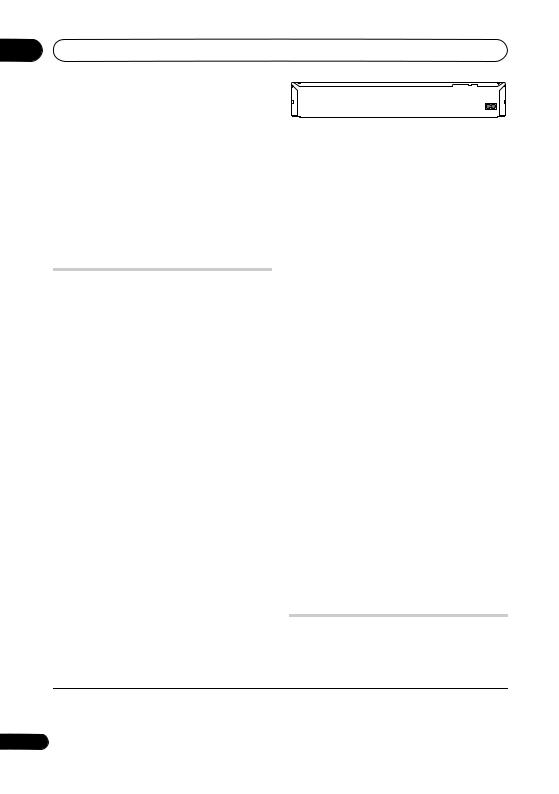
02 Connections
2Use a SCART cable (not supplied) to connect the AV1 (RGB)-TV AV connector to a SCART AV connector on your TV.
This enables you to watch discs.
3Use another SCART cable to connect the AV2 (INPUT 1/DECODER) AV connector to a SCART AV connector on your decoder box.
This enables you to record scrambled TV channels.
Connecting to an AV amplifier/receiver
To enjoy multichannel surround sound you need to connect this recorder to an AV amplifier/receiver using the digital coaxial output.
In addition to a digital connection, we recommend also connecting using the stereo analog connection for compatibility with all discs and sources.
You’ll probably also want to connect a video output to your AV amplifier/receiver. Use the ordinary video output (as shown here), or the S-video output.
 Important
Important
•Noise may be output from your speakers if the recorder is not set up to work with your AV amplifier/receiver properly (see Audio Out on page 133).
•When watching D.TV only linear PCM audio is output from the coaxial digital out jack.
•Do not connect this recorder to your TV ‘through’ your VCR using A/V cables. Always connect it directly to your TV.
ANTENNA |
R |
AUDIO |
L VIDEO |
|
|
|
|
|
DIGITAL |
IN |
|
|
|
S-VIDEO |
|
|
|
|
AUDIO OUT |
|
|
|
|
INPUT 3 |
AV 2 (INPUT 1/DECODER) |
|
|
|
AC IN |
|
|
|
|
|
|
ANTENNA(DIGITAL) |
HDMI OUT COAXIAL |
||
|
|
|
|
|
|
G-LINK IN |
|
||
|
|
|
|
|
|
OUT |
IN |
|
|
OUT |
|
|
|
OUTPUT |
|
|
|
|
|
|
Y |
PB |
PR |
|
AV 1 (RGB) – TV |
CONTROL |
5 V |
30 mA |
|
|
COMPONENT VIDEO OUT |
|
|
|
|
|
|||
|
|
|
|
AUDIO/VIDEO |
|
|
|
DIGITAL |
|
|
|
|
|
|
OUTPUT |
|
|
|
AUDIO OUT |
3 |
2 |
To audio/video input |
To digital input |
AV amp/ |
From video |
|
output |
||
receiver |
||
|
||
|
4 |
|
|
To video input |
|
TV |
|
1 Connect your TV antenna to the recorder and TV.
See Connecting a TV antenna on page 15 for details.
This enables you to watch and record TV channels.
2Connect the DIGITAL AUDIO OUT (COAXIAL) jack on this recorder to a coaxial digital input on your AV amplifier/receiver.
This enables you to listen to multichannel surround sound.
3Connect the analog AUDIO OUTPUT and VIDEO OUTPUT jacks on this recorder to an analog audio and video input on your AV amplifier/receiver.
4Connect the AV amplifier/receiver’s video output to a video input on your TV.
Connecting using HDMI
If you have an HDMI or DVI-equipped1
monitor or display2, you can connect it to this recorder using an HDMI cable (not supplied).
 Note
Note
1 Depending on the component you have connected, using a DVI connection may result in unreliable signal transfers.
2 The pixel resolution of this recorder’s HDMI video output is (according to TV format): NTSC (720 x 480i/p, 1280
20x 720p, 1920 x 1080i/p) and PAL (720 x 576i/p, 1280 x 720p, 1920 x 1080i/p). If your display is not compatible with these resolutions the picture may not be correctly reproduced.
En

Connections |
02 |
The HDMI connector outputs uncompressed digital video, as well as almost every kind of digital audio.
1 Use an HDMI cable to connect the HDMI OUT connector on this recorder to an HDMI connector on an HDMIcompatible display.
HDMITo HDMI
INinput
HDMI-compatible display
HDMI
OUT
ANTENNA |
R |
AUDIO |
L |
VIDEO |
|
|
|
|
|
|
DIGITAL |
IN |
|
|
|
|
S-VIDEO |
|
|
|
|
|
AUDIO OUT |
|
|
|
|
|
|
|
|
|
|
|
|
|
|
|
|
|
INPUT 3 |
AV 2 (INPUT 1/DECODER) |
|
|
|
|
AC IN |
|
|
|
|
|
|
|
ANTENNA(DIGITAL) |
HDMI OUT |
COAXIAL |
||
|
|
|
|
|
|
G-LINK |
IN |
OUT |
IN |
|
|
OUT |
|
|
|
|
OUTPUT |
|
|
|
|
|
|
|
Y |
|
PB |
PR |
|
AV 1 (RGB) – TV |
CONTROL |
5 V |
30 mA |
|
|
|
COMPONENT VIDEO OUT |
|
|
|
|
|
|
||||
•The arrow on the cable connector body should be face down for correct alignment with the connector on the recorder.
When connected to an HDMI component or HDCP-compatible DVI component, the HDMI indicator lights.
HDMI setup is generally automatic. There are however settings you can change if you need to. See HDMI Output (only available when an HDMI device is connected) on page 138 for more information. Note that the HDMI settings remain in effect until you change them, or connect a new HDMI component.
 Important
Important
•An HDMI connection can only be made with DVI-equipped components compatible with both DVI and Highbandwidth Digital Content Protection (HDCP). If you choose to connect to a DVI connector, you will need a DVI to
HDMI adaptor cable. A DVI to HDCP connection, however, does not support audio. Consult your local audio dealer for more information.
•The HDMI connection is compatible with 32 kHz, 44.1 kHz, 48 kHz, 96 kHz, 16 bit/ 20 bit/24 bit 2-channel linear PCM signals, as well as Dolby Digital, DTS and MPEG audio bitstream.
•If your connected component is only compatible with Linear PCM, the signal is output as Linear PCM (DTS audio is not output).
•If you have connected to a Pioneer plasma display, please select the HDMI setup on the display (refer to the supplied manual for more on this).
About HDMI
HDMI (High-Definition Multimedia Interface) supports both video and audio on a single digital connection for use with DVD players and recorders, DTV, set-top boxes, and other AV devices. HDMI was developed to provide the technologies of Highbandwidth Digital Content Protection (HDCP) as well as Digital Visual Interface (DVI) in one specification. HDCP is used to protect digital content transmitted and received by DVI-compliant displays.
HDMI has the capability to support standard, enhanced, or high-definition video plus standard to multi-channel surroundsound audio. HDMI features include uncompressed digital video, a bandwidth of up to five gigabits per second (Dual Link), one connector (instead of several cables and connectors), and communication between the AV source and AV devices such as DTVs.
HDMI, the HDMI logo and High-Definition Multimedia Interface are trademarks or registered trademarks of HDMI licensing LLC.
21
En
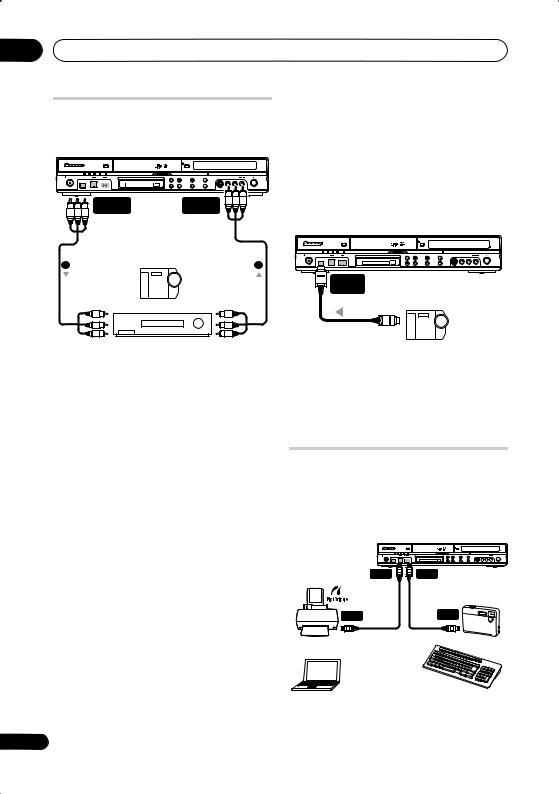
02 Connections
Connecting other AV sources
Connecting a VCR or analog camcorder
|
|
|
|
|
|
|
|
|
|
|
|
|
|
AUDIO/VIDEO |
AUDIO/VIDEO |
|||||
|
OUTPUT |
INPUT |
||||
(Rear panel) |
(Front panel) |
|||||
1 |
|
2 |
To audio/video input |
Analog camcorder |
From audio/video output |
VCR
1Connect a set of audio and video inputs of your VCR or camcorder to a set of outputs on this recorder.
This enables you to record from this recorder to your VCR or camcorder.
•You can use standard video or S-video cables for the video connection.
•Alternatively, you can use the AV2 (INPUT 1/DECODER) SCART connector for audio/video input and output with just one SCART cable.
2Connect a set of audio and video outputs of your VCR or camcorder to a set of inputs on this recorder.
This enables you to record tapes from your VCR or camcorder.
•You can use standard video or S-video cables for the video connection.
•The front panel connections make convenient connections for a camcorder input.
•When connecting an external AV source that only supports monaural sound, only insert the left (white) audio jack to this device. Doing so will allow the same sound track to be recorded to both channels. You must connect to the
22 INPUT 2 jack on the front panel.
Connecting a DV camcorder
You can connect a DV camcorder or DVD recorder with DV output to the front panel DV IN jack.
 Important
Important
•This jack is for connection to DV equipment only. It is not compatible with digital satellite receivers or D-VHS video decks.
DV
IN
From DV output
DV camcorder
•Use a DV cable (not supplied) to connect the DV jack of your DV camcorder to the front panel DV IN jack of this recorder.
Connecting a USB device
Using the USB ports on the front of the recorder you can connect USB devices such as digital cameras, printers, keyboards and PCs. Please also see the instructions that came with the device you want to connect before using.
USB |
USB |
(Type B) |
(Type A) |
USB |
USB |
PictBridge-compatible |
Digital Camera |
|
|
Printer |
|
PC |
Keyboard |
|
En

Connections |
02 |
 Important
Important
•Some USB devices may not work with this recorder.
•When connecting a PC to this unit, make sure the power is turned off on both the PC and this unit when you connect them via USB.
•We recommend connecting USB devices when this recorder is switched off (in standby).
JPEG file storage devices
•Digital still camera
•Memory card reader (any type of memory card)
•USB memory
The Mass Storage Class (MSC) device should be FAT-compatible. Note that if the device is partitioned, this recorder may not recognize it.
The Picture Transfer Protocol (PTP) can be used to transfer up to a maximum of 4000 files.
WMA/MP3 file storage devices
•Memory card reader (any type of memory card)
•USB memory
•PC (Use Connect PC function)
The Mass Storage Class (MSC) device should be FAT-compatible. Note that if the device is partitioned, this recorder may not recognize it.
Note that although multi-slot card readers can be used, the recorder will only recognize the first card inserted. To read another card, remove all the cards and insert the card to be read again.
Using a USB hub
•Use a hub compatible with USB 1.1 and/ or 2.0.
•Use an independently powered hub (bus powered hubs may not work reliably).
•In the event of unreliable operation with the hub, we recommend plugging the device directly into the recorder’s USB port.
•Operation may become unreliable if too many devices are connected to the hub. In this case, try unplugging some devices.
•If the power delivered through a hub is insufficient for the devices connected, communication can become unreliable. In this case, disconnect one or more devices then perform a USB restart. (See
Restart USB Device on page 140.)
Using a USB printer
• Use a PictBridge-compatible printer.
Using a USB keyboard
•Do not use a PS/2 keyboard connected using a PS/2-USB adapter.
Using a PC
•Note that you can connect a PC to this device via USB to copy WMA and MP3 files. For more information, see Connect PC on page 109. To use Connect PC with this device, your PC must run either the Windows XP Home Edition (SP2) or Windows XP Professional (SP2) operating system and be able to run Windows Media Player 10. Even if your PC can run Windows Media Player 10, we cannot guarantee that it will function properly with this device. For more details see the ‘Help’ section of Windows Media Player 10.
Plugging in
After checking all the connections, plug in the recorder.
• Use the supplied power cable to connect this recorder to a power outlet.
23
En
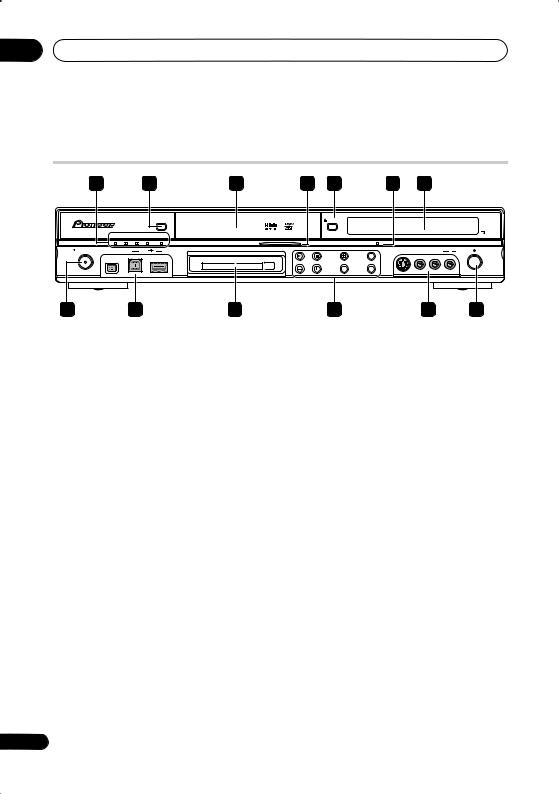
03 Controls and displays
Chapter 3
Controls and displays
Front panel
1 |
|
2 |
3 |
4 |
5 |
6 |
7 |
|
|
|
|
|
|
HDD/DVD |
|
OPEN/CLOSE |
|
|
|
|
|
|
A.TV |
D.TV PLTV DivX |
COPY |
|
|
HDMI |
|
|
|
|
STANDBY/ON |
DV IN |
USB |
COMMON INTERFACE |
|
|
INPUT 2 S-VIDEO |
VIDEO L(MONO) |
R |
AUDIO |
REC |
|
|
|
|
|
STOP REC |
ONE TOUCH |
|
|
|
|
|
|
|
|
|
|
COPY |
|
|
|
|
CH |
INPUT |
A.TV/D.TV |
|
SELECT |
|||
|
|
8 |
9 |
10 |
11 |
9 |
12 |
1A.TV indicator
Lights when analog TV is selected.
D.TV indicator
Lights when digital TV is selected.
4 HDD/DVD indicator
Indicator lights blue when the hard disk (HDD) is selected; orange when the DVD drive is selected.
5 OPEN/CLOSE
PLTV indicator
Lights during recording started using the Pause Live TV feature.
DivX indicator
Lights during DivX playback.
COPY indicator
Lights when copying is underway.
2 HDD/DVD
Press to switch between HDD and DVD for recording and playback.
3 Disc tray
Press to open/close the disc tray.
6 HDMI indicator
Lights when this recorder is connected to HDMI (HDCP) compatible component.
7Front panel display and IR remote sensor
See Display on page 26 for details.
8STANDBY/ON
Press to switch the recorder on/into standby.
9 Front panel inputs
See Front panel connections on page 15 for more information on these.
10 COMMON INTERFACE slot
Slot for CA module and smart card used to decode scrambled D.TV channels. See
Common Interface on page 25.
24
En
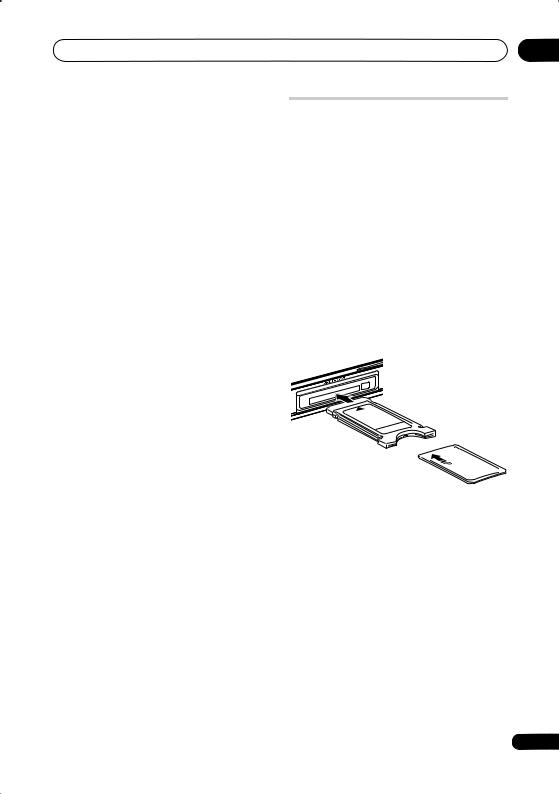
Controls and displays
11
Press to start or restart playback.
Press to stop playback.
STOP REC
Press to stop recording.
ONE TOUCH COPY
Press to start One Touch Copy of the currently playing title to DVD or the HDD.
CH +/–
Use to change channels, skip chapters/ tracks, etc.
INPUT SELECT
Press to change the input used for recording.
A.TV/D.TV
Switches between analog TV antenna input and digital TV antenna input. The A.TV and D.TV indicators show which is selected.
12 REC
Press to start recording. Press repeatedly to set the recording time in 30 minute blocks.
03
Common Interface
To receive scrambled D.TV channels you will need a CA module and smart card provided by your service provider.
Different CA modules support different encryption systems. This recorder is designed to work with modules that support the DVB standard. Contact your service provider to obtain the right kind of CA module.
Note that neither CA modules nor smart cards are supplied or sold by Pioneer.
Inserting a CA module
The Common Interface card slot is located on the front panel of the recorder.
• Insert the CA module into the card slot as far as it will go.
The Common Interface card slot accepts Type I and Type II PC Cards (PCMCIA cards).
25
En
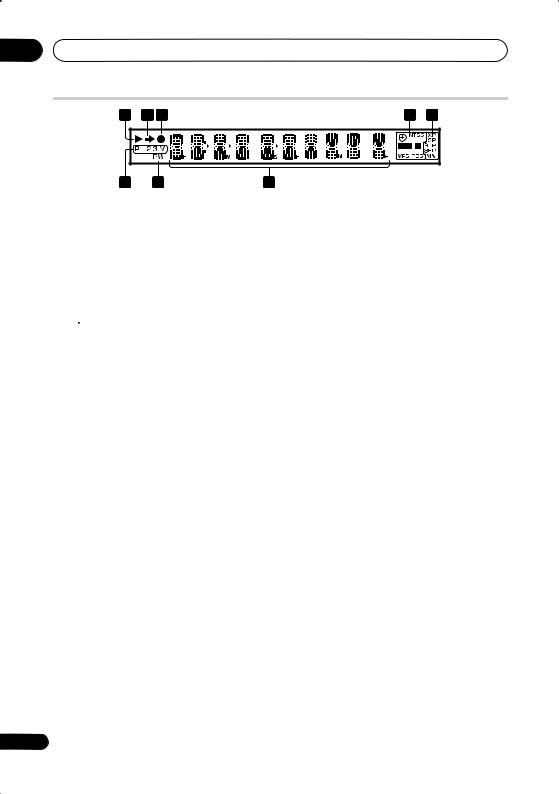
03 Controls and displays
Display
1 |
2 |
3 |
4 |
5 |
|
|
L |
R |
P |
|
8 |
7 |
6 |
1 |
|
|
|
Lights during playback; blinks when |
|
||
playback is paused. |
|
|
|
2 |
|
|
|
Lights when copying.
3
Lights during recording; blinks when recording is paused.
4 (page 68)
(page 68)
Lights when a timer recording has been set. (Indicator blinks if the timer has been set to DVD but there isn’t a recordable disc loaded, or the timer has been set to record to the HDD but the HDD is not recordable.)
NTSC
Lights when the video output signal format is NTSC.

 (page 132)
(page 132)
Indicates which channels of a bilingual broadcast are recorded.
 (page 131)
(page 131)
Lights when the component video output is set to progressive scan.
VPS/PDC (page 68)
Lights when receiving a VPS/PDC broadcast during a VPS/PDC-enabled timer recording.
5Recording quality indicators (page 64)
XP
Lights when the recording mode is set to XP (high quality).
SP
Lights when the recording mode is set to SP (standard play).
26
LP/SLP
Lights when the recording mode is set to LP (long play) or SLP (super-long play).
EP/SEP
Lights when the recording mode is set to EP (extended play) or SEP (superextended play).
MN
Lights when the recording mode is set to MN (manual recording level) mode.
6Character display
7R/RW
Lights when a recordable DVD-R or DVD-RW disc is loaded.
8PL (page 89)
Lights when a VR mode disc is loaded and the recorder is in Play List mode.
2 3 (page 139)
Shows the remote control mode (if nothing is displayed, the remote control mode is 1).
V
Lights when an unfinalized Video mode disc is loaded.
En
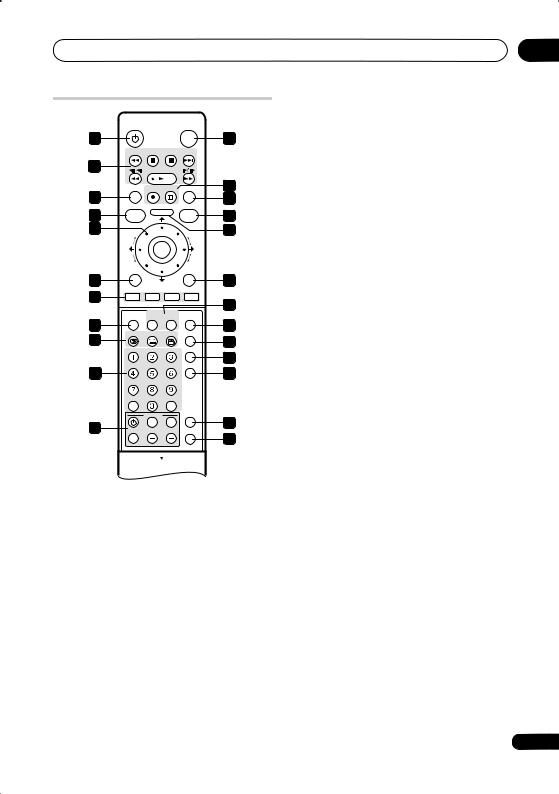
Controls and displays
Remote control
|
STANDBY/ON |
|
|
HDD/DVD |
|
1 |
|
|
|
|
12 |
|
PREV |
PAUSE |
STOP |
NEXT |
|
2 |
|
PLAY |
|
|
|
3 |
HELP |
REC |
STOP REC |
INFO |
13 |
TOP MENU |
|
|
|
14 |
|
|
|
|
|
|
|
4 |
DISC |
HOME MENU |
GUIDE |
15 |
|
NAVIGATOR |
|
|
|||
5 |
CHANNEL |
|
|
CM BACK |
16 |
|
+ |
|
|
|
|
|
|
ENTER |
|
|
|
|
– |
|
|
|
|
|
CHANNEL |
|
|
CM SKIP |
|
|
A.TV/D.TV |
|
|
RETURN/EXIT |
|
6 |
|
|
|
|
17 |
7 |
|
|
|
|
18 |
|
PAUSE |
TIMER |
|
ONE TOUCH |
|
|
|
|
|||
8 |
LIVE TV |
REC |
REC MODE |
COPY |
19 |
AUDIO |
|
|
INPUT SELECT |
||
9 |
SUBTITLE |
ANGLE |
|
||
|
ABC |
DEF |
MENU |
20 |
|
|
|
21 |
|||
|
|
|
|
DISPLAY |
|
10 |
GHI |
JKL |
MNO |
22 |
|
|
|
|
|
||
|
PQRS |
TUV |
WXYZ |
|
|
+CLEAR CLEAR
|
|
TV CONTROL |
TEXT |
|
11 |
INPUT SELECT CHANNEL VOLUME |
23 |
|
TV/DVD |
||
|
|
|
24 |
|
|
OPEN |
|
1 |
STANDBY/ON |
|
|
Press to switch the recorder on/into standby.
2 PLAY (page 74)
Press to start playback.
PAUSE
Press to pause playback or recording.
STOP (page 74)
Press to stop playback.
PREV NEXT
Press to skip to the previous or next title/ chapter/track/folder; or to display the previous or next menu page.
When GUIDE Plus+® is displayed, use to display the previous/next page.
03
(page 79)
Press to start reverse or forward scanning. Press again to change the speed.
(page 79)
While paused, press and hold to start slow-motion playback. Press repeatedly to change the playback speed.
While paused, press to advance a single frame in either direction.
When GUIDE Plus+® is displayed, use to display the previous/next day.
3 HELP
Press for help on how to use the current GUI screen.
4DISC NAVIGATOR (page 78, 89)/ TOP MENU (page 75)
Press to display the Disc Navigator screen, or the top menu if a DVD-Video or finalized DVD-R/-RW (Video) disc is loaded.
5/ / / and ENTER (Smart Jog)
Used to navigate all on-screen displays. Rotate the Smart Jog to move the cursor up or down. Press ENTER to select the currently highlighted option.
When using the Smart Jog, turn it lighty to avoid pressing down on the cursor keys.
While watching D.TV press ENTER to display the Channel List screen.
Rotate the Smart Jog when playback is paused to do a frame-by-frame search back/forward.
CM BACK (commercial back)
Turn the Smart Jog counter-clockwise during playback to skip progressively backward through the video playing.
CM SKIP (commercial skip)
Turn the Smart Jog clockwise during playback to skip progressively forward through the video playing.
CHANNEL +/– (page 61)
While stopped, turn the Smart Jog to change the channel of the built-in TV tuner.
27
En

03 Controls and displays
6 A.TV/D.TV
Press to switch between analog TV antenna input and digital TV antenna input. The A.TV and D.TV indicators on the front panel show which is selected.
7Colour buttons
(RED, GREEN, YELLOW, BLUE)
Use when an EPG screen is displayed or when tuned to a data channel of a digital broadcast. The function of each button will be described on-screen, and changes depending on the screen being displayed.
8 PAUSE LIVE TV (page 66)
Press to start recording the current TV channel, but with playback paused, effectively pausing the broadcast.
9 AUDIO (page 62, 63, 82, 83) Press to change the audio language or
AUDIO (page 62, 63, 82, 83) Press to change the audio language or
channel. (When the recorder is stopped, press to change the tuner audio.)
 SUBTITLE (page 82)
SUBTITLE (page 82)
Press to display/change the subtitles included in multilingual DVD-Video discs.
While watching D.TV, press to change the D.TV subtitles.
 ANGLE (page 83)
ANGLE (page 83)
Press to switch camera angles on discs with multi-angle scenes.
10Number buttons, CLEAR, +
Use the number buttons for track/chapter/ title selection; channel selection, and so on. The same buttons can also be used to enter names for titles, discs and so on.
Use CLEAR to clear an entry and start again.
11TV CONTROL buttons (page 143) After setting up, use these controls to control your TV.
12HDD/DVD (page 64)
Press to select the hard disk (HDD) or DVD for recording and playback.
28
13 Recording controls (page 64)
REC
Press to start recording. Press repeatedly to set the recording time in blocks of 30 mins.
When the red action button is visible in a GUIDE Plus+® screen, use for One- Button-Record.
STOP REC
Press to stop recording.
14 INFO
While watching D.TV, press to display the information banner.
Press to see additional information for the highlighted item in the EPG.
15 GUIDE
Press to display the EPG screen; press again to exit.
16 HOME MENU
Press to display the Home Menu, from which you can navigate all the functions of the recorder.
17 RETURN/EXIT
Press to go back one level in the on-screen menu or display.
Also press to exit the MHEG application.
18TIMER REC (page 38, 68) Press to set a timer recording.
REC MODE (page 64)
Press repeatedly to change the recording mode (picture quality).
19ONE TOUCH COPY (page 100) Press to start One Touch Copy of the currently playing title to DVD or the HDD.
20INPUT SELECT (page 70)
Press to change the input to use for recording.
21 MENU (page 75)
Press to display the disc menu if a DVDVideo, finalized DVD-R/-RW (Video mode) or finalized DVD+R/+RW disc is loaded.
When in the GUIDE Plus+® system, use to jump directly to the Menu bar.
En

Controls and displays |
03 |
22 DISPLAY (page 84)
Displays/changes the on-screen information displays.
23 TEXT (page 62, 63)
Press to display Teletext information (in European countries except the UK) or to start the MHEG application display (UK only) if available during digital broadcasts.
24 TV/DVD
Press to switch between ‘TV mode’, in which you get the picture and sound from the TV’s tuner, and ‘DVD mode’, in which you get picture and sound from the recorder’s tuner (or an external input).
29
En
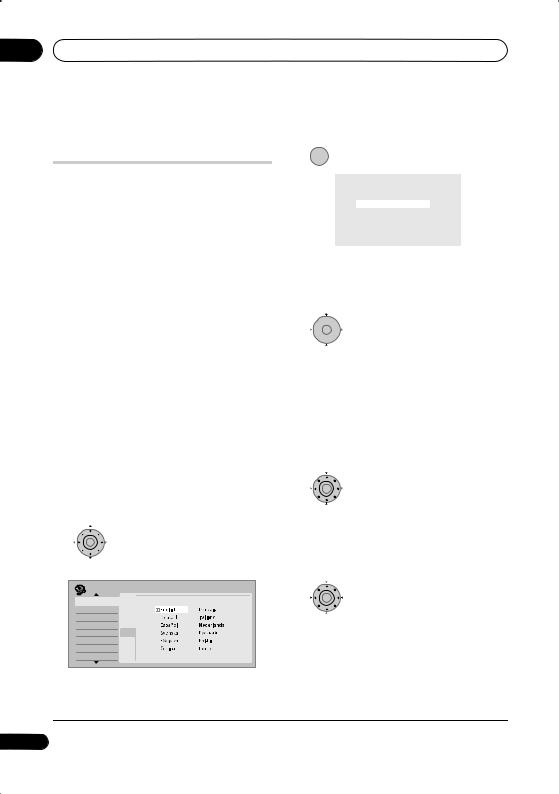
04
30
En
Getting started
Chapter 4
Getting started
Switching on and setting up
When you switch the recorder on for the first time, you can make several basic settings using the Setup Navigator feature. This takes you through setting the clock, the internal TV tuner and the video output.
If you’re using the recorder for the first time, we strongly recommend you use the Setup Navigator before starting to use the recorder.
1 Switch on your TV and set the video input to this recorder.
4 ENTER Start the Setup Navigator.
Complete this setup before you start using your recorder.
Start
p Navigator Cancel
Please use the Initial Setup if you want to make more detailed settings.
•If you don’t want to use the Setup Navigator, press to select Cancel, then press ENTER to exit the Setup Navigator.
STANDBY/ON |
ENTER |
2  Switch on the recorder.
Switch on the recorder.
When you switch on for the first time, your TV should display the Setup Navigator screen (If the Setup Navigator doesn’t appear, you can also access it from the Initial Setup menu; see page 127).
•If this recorder is connected to a compatible TV using a fully-wired 21-pin SCART cable, the recorder will take a few seconds to download country, TV screen size and language information. (Check the manual that came with your TV for compatibility information.)
ENTER |
|
3 |
Choose a language (then |
press ENTER). |
|
Initial Setup |
|
Basic |
Clock SettingLanguage |
Tuner |
Input Line System |
Video In/ O ut |
Power Save |
Audio In |
HELPp |
Audio O ut |
Setup N avig ator |
Language |
|
Recording |
|
Playback |
|
5  Select an Aerial Power setting1 for the built-in digital tuner.
Select an Aerial Power setting1 for the built-in digital tuner.
•On: power is always supplied to the connected aerial, whether the recorder is on or in standby.
•Auto: power is only supplied when this recorder is on.
•Off: power is never supplied to the aerial.
6 |
ENTER |
Select ‘Auto Scan’ to start |
scanning for D.TV channels.
•Select Do not set if you want to skip D.TV channel setup (because they have already been set up, for example), then skip to step 8 below.
|
ENTER |
7 |
Select your country. |
The recorder starts scanning for new channels. After the scan is complete the recorder will let you know how many new channels were found.
•The country setting will apply to both the digital and analog TV tuners.
 Note
Note
1If the recorder does not accept the On or Auto setting (the highlight jumps back to Off), check that the antenna is properly connected and that it is not shorted, then try making the setting again.
